CRAFTING PERSONAL JOURNEYS
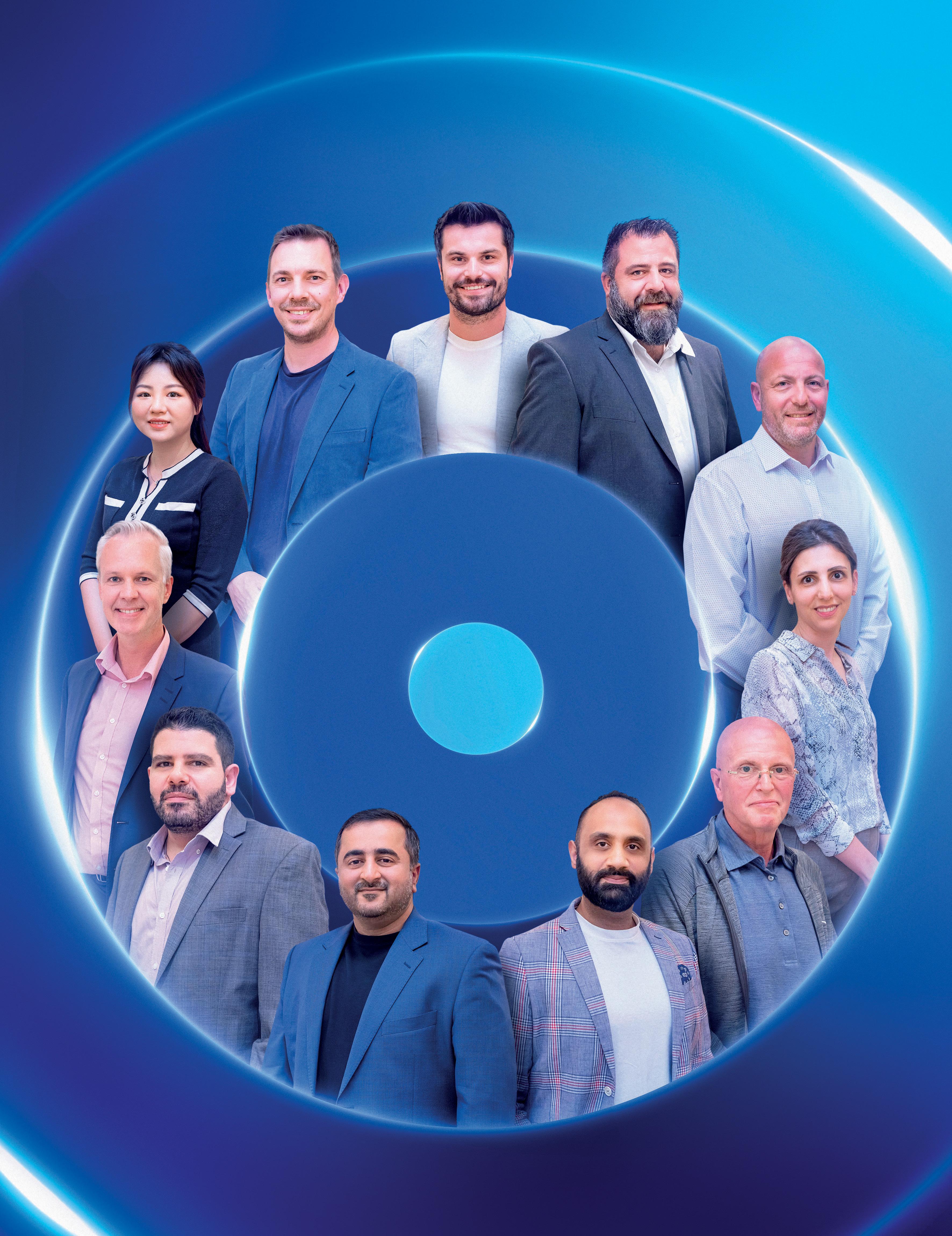
Experts share insider secrets to hyper-personalising experiences and keeping viewers engaged
ISSUE 161 | MARCH 2024 Licensed by Dubai Development Authority



LAWO.COM DISCOVER ELASTICITY. HOME Apps SERVER-BASED PROCESSING XS ST2110 Multiviewer Graphic Inserter UDX Conversion with HDR Processing Stream Transcoder See you at NAB C4110

GROUP
Managing Director Raz Islam raz.islam@cpitrademedia.com
+971 (0) 4 375 5471
Managing Partner Vijaya Cherian vijaya.cherian@cpitrademedia.com
+971 (0) 55 105 3787
Director of Finance & Business Operations Shiyas Kareem shiyas.kareem@cpitrademedia.com
+971 (0) 4 375 5474
EDITORIAL
Editor Vijaya Cherian vijaya.cherian@cpitrademedia.com
+971 (0) 55 105 3787
Sub Editor Aelred Doyle
ADVERTISING
Group Sales Director Sandip Virk sandip.virk@cpitrademedia.com
+971 (0) 50 929 1845 / +44 (0) 7516 993 862
DESIGN & PHOTOGRAPHY
Art Director Simon Cobon simon.cobon@cpitrademedia.com
Designer Percival Manalaysay percival.manalaysay@cpitrademedia.com
Photographer Maksym Poriechkin maksym.poriechkin@cpitrademedia.com
MARKETING & EVENTS
Events Executive Priyanka Raina priyanka.raina@cpitrademedia.com
CIRCULATION & PRODUCTION
Data & Production Manager
Phinson Mathew George phinson.george@cpitrademedia.com
DIGITAL SERVICES
Web Developer Abdul Baeis abdul.baeis@cpitrademedia.com
Web Developer Umair Khan umair.khan@cpitrademedia.com
FOUNDER
Dominic De Sousa (1959-2015)
Published by

We have just returned from Riyadh after our inaugural conference in Saudi Arabia, and I am elated at the incredibly high level of discussions that took place at the event and the fabulous turnout. We started with the one topic that keeps the region’s media entities on its toes today – content. Arabic content and hyperlocal content seem to be the trend in the Arab world, and it was so rewarding to have brought together a high-profile Hollywood producer who has bought a local format and plans to film his first Arabic feature in KSA before the end of the year; one pan-Arab content broadcast major with Saudi roots; a local producer; and the CEO of Media at Neom, which hopes to have a whopping 5o studios when they have eventually completed their construction. Our tech, OTT and news panels as well as presentations from industry trendsetters and fireside chats were equally informative. Networking in the accompanying lobby was in full swing and many stayed until the end of the day. We had new iPad Pros as giveaways from Fonn Group and Viaccess. We hope to make the Riyadh edition bigger, better and more enriching next year.
Unfortunately, we are heading off to press and there’s no time to share more. Panel discussions will be summed up in subsequent issues of the magazine. Until then, enjoy the photos that we have posted on our websites and social media platforms. The videos will be up soon.
A couple of weeks prior to the Riyadh conference, BroadcastPro also got together with BytePlus, the enterprise tech arm of ByteDance, to run a roundtable on personalising the entertainment experience for viewers. Industry experts unlock some of their secrets just for you in this issue. You are likely to learn a trick or two. Until the next issue, Ramadan Mubarak.
 VIJAYA CHERIAN, EDITORIAL DIRECTOR
VIJAYA CHERIAN, EDITORIAL DIRECTOR
1 PRO | INTRO broadcastprome.com
The publisher of this magazine has made every effort to ensure the content is accurate on the date of publication. The opinions and views expressed in the articles do not necessarily reflect the publisher and editor. The published material, adverts, editorials and all other content are published in good faith. No part of this publication or any part of the contents thereof may be reproduced, stored or transmitted in any form without the permission of the publisher in writing. Publication licensed by Dubai Development Authority to CPI Trade Publishing FZ LLC. Printed by Masar Printing. CPI Trade Media. PO Box 13700, Dubai, UAE. +971 4 375 5470 cpitrademedia.com © Copyright 2024. All rights reserved.
WELCOME

7
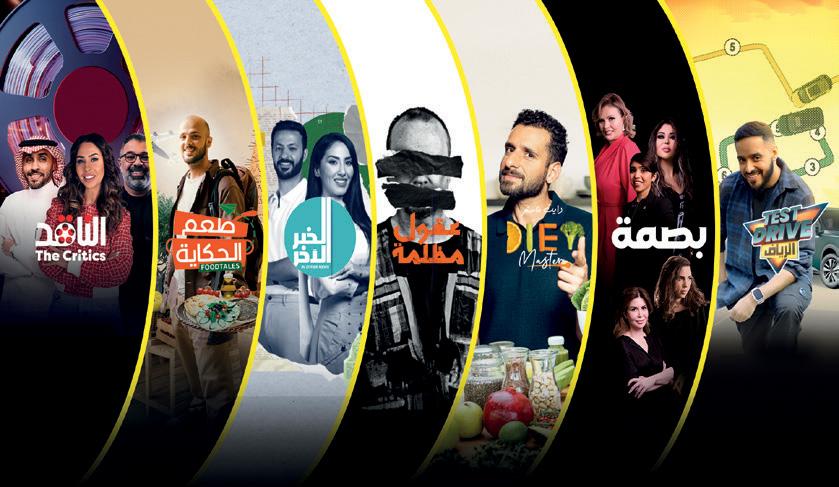
COVER YOUR COUCH, YOUR CONTENT
Although personalisation is at the heart of enriching the entertainment experience, at a roundtable hosted by BroadcastPro ME and ByteDance MENA, experts reiterated that its efficacy relies on a multitude of factors that shape its success or failure.

CASE STUDY BENEATH THE WAVES
When Turkish DoP Murathan Yildiz joined a group of ten professional underwater photographers and technical divers from across the globe for a five-day expedition in Gallipoli, Turkey to capture some of the shipwrecks that lie beneath its depths, he turned to the Blackmagic Pocket Cinema Camera 6K.
32 Q&A
UPDATE NEWS
Yango Play launches in GCC; Asharq Discovery unveils seven original Arabic productions; Content platform Million launches in MENA; Indian channel now on Shahid; Blue Engine Studios names new shareholder and Board Chairman; Evision and Disney Star forge deal; and more

REVIEW SHOOTING STAR
The small and compact Sony Burano packs a punch with its myriad features, including an auto-focus function that makes it well-suited for solo shoots, says Dubai-based DoP Timothy Fare-Matthews.
22

ELIE EL SEMAAN’S TAKE ON ARABIC CONTENT
Canadian-Lebanese film director Elie El Semaan has a versatile body of work including music videos, TV commercials and three drama series that have enjoyed success on Shahid. He talks about his career, his upcoming Netflix debut and the rising popularity of Arabic content.
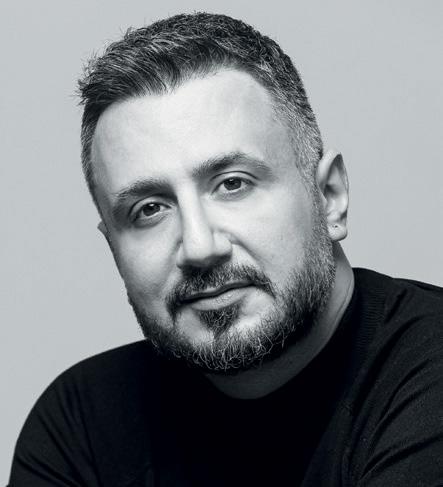
3 PRO | CONTENTS broadcastprome.com
28 14

TV

TV

TRENDS: What to expect in 2024 – Prediction I



TV

INTERVIEW: Elevating esports broadcasts with tech

OPINION: Building brand advocacy through impactful digital experiences
4 PRO | ONLINE MARCH 2024
LATEST NEWS TECH FEATURES
SAWA Rights Management secures channel rights for Padel Time TV in MENA
Vodafone Qatar selects Babeleye to power GigaTV video service metadata
Thmanyah and AlThaqafeyah ink deal to broadcast documentaries
SATELLITE BICS partners with Skylo to deliver NB-IoT connectivity
FILM
Tunisian film The Island of Forgiveness to screen at NVIC in Cairo
Let’s create a vibrant online broadcast community!
@BroadcastProME www.facebook.com/BroadcastProME BroadcastProME
FEATURED NEWS





FILM
I-Film Festival wraps up at Yas Creative Hub
The festival highlighted Abu Dhabi’s growing prominence as a global content hub, with substantial support from the Abu Dhabi Film Commission and Creative Lab
TRENDING

TV
BeIN
OTT
Netflix streams Saudi unscripted docu-series Camel Quest
It is the second high-profile project from Saudi Arabia to feature camels in a major role

FILM
Red Sea International Film Festival announces dates for fourth edition
FILM
Saudi Film Commission to participate at 74th Berlinale
The Saudi pavilion aims to inspire global producers to explore the the Kingdom’s captivating filming locations
FILM
Doha Film Institute announces Qumra Masters for 10th incubator event
The Qumra Masters give a masterclass and then provide oneon-one mentorship to participants

CINEMA
Roxy

OTT
NEWS
Netflix and Women in Animation Nepal shine spotlight on under-represented voices Netflix’s commitment to knowledge transfer and talent cultivation in the region underscores its dedication to fostering diverse voices and narratives
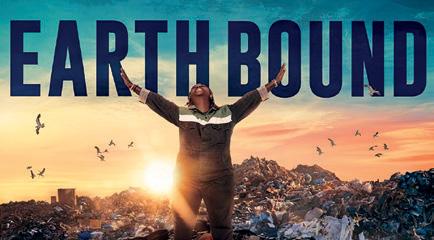
TV
Keshet
5 PRO | ONLINE broadcastprome.com
Sports records viewership of 707.3m for AFC Asian Cup Qatar 2023
International acquires Orlando Bloom’s docuseries Earthbound
Cinemas hosts live screening of AFC Asian Cup 2023 final
Netflix original From the Ashes emerges as Saudi Arabia’s biggest global hit
Es’hailSat deli v ers sat elli t e se r vices f or
b r oadcast, b r oadband, mobilit y , corporat e and g ov ernment se r vices ac r oss t he Middle East and No r t h Africa, and b ey ond.
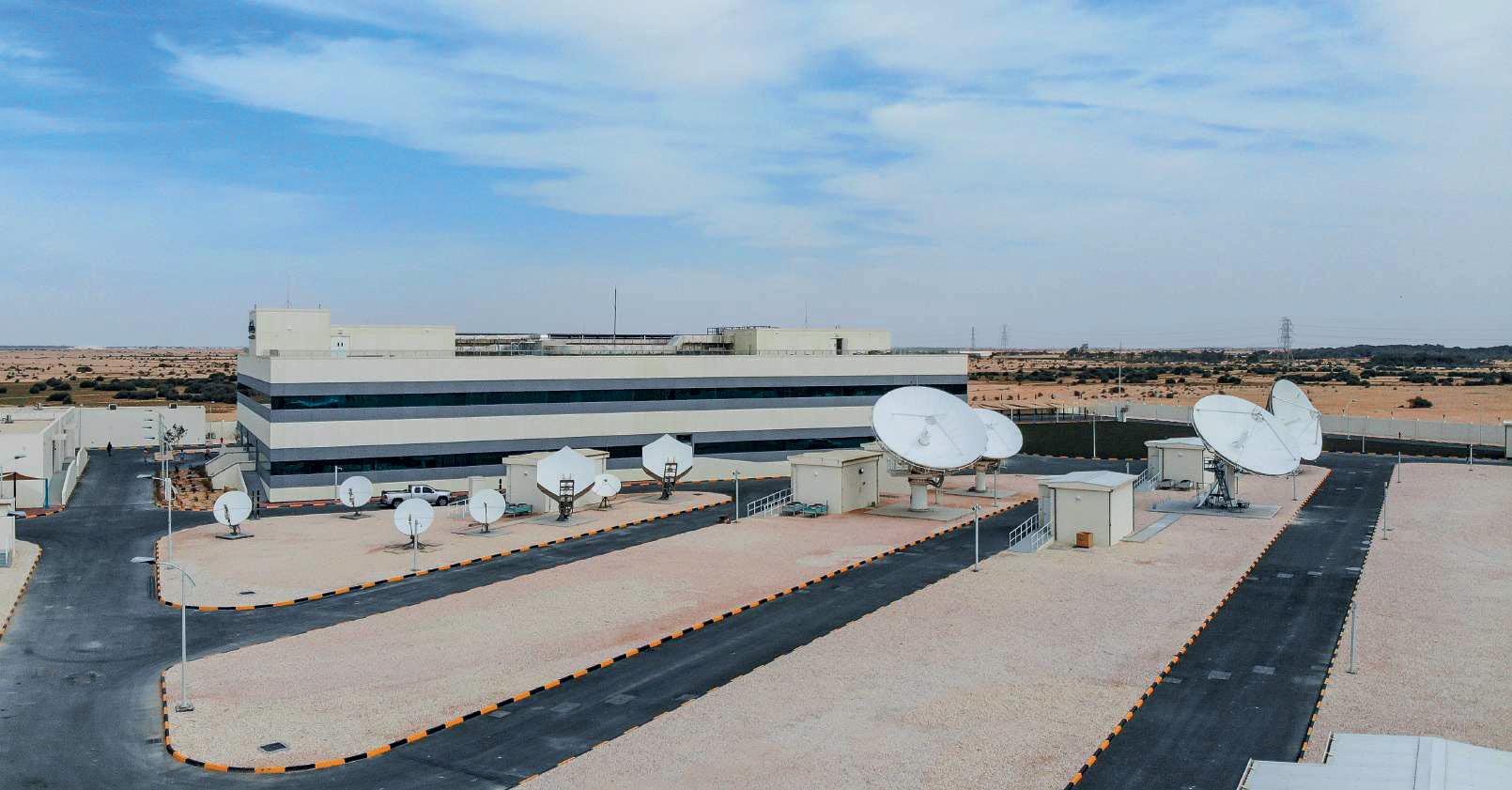
Our
50,000sqm Dir ec t - t o-Home Contribution and Occasional Use Se r vices Play out Br oadcast Distribution Video Services Telepor t Services Telecom Services Maritime / Oil&Gas IP Trunking VSAT Net w orks Cellular Backhaul An t enna Hosting www eshailsat qa
Products and Ser vices include: 5 0,000sqm Facility Priv at e Data Cen t er Suit e Par tial Cabinet Full Rack
5 , 00 sq runking


03/24
Yango Play from ‘Russia’s Google’ comes to GCC
Yango, a subsidiary of Yandex, popularly known as ‘Russia’s Google’, has launched Yango Play, an entertainment service integrating video streaming, music and mini games. Powered by an AI Arabic voice assistant called Yasmina, the app is now available in Saudi Arabia, the UAE and other GCC countries. Subscribers will have cross-platform access via smartphones and TVs.
This super app champions regional production studios and artists. Serving as a launchpad for local talent, Yango Play offers original

content that resonates with cultural identities.
Yasmina is fluent in the Khaleeji language as well as other major Arabic dialects, including Egyptian and Lebanese.
A cornerstone of Yango Play’s innovation is its AI-powered endless music stream, crafting personalised playlists based on user preferences and spotlighting regional gems.
Roman Shimansky, MENA Region Business Director at Yango Play, said the app was “devoted to crafting a joyful entertainment experience, offering a selection of diverse content” to users.
Upon sign-up, users receive a 60-day free subscription, followed by a monthly paid plan of $8.17 for multiple devices in the UAE.
GEA TO PRODUCE 14 EGYPTIAN AND SAUDI FILMS
Turki Alalshikh, Chairman of Saudi Arabia’s General Entertainment Authority (GEA), has inked a deal to launch a fund with a budget of $130m, with the potential to expand to $650m, aimed at bolstering the production of Egyptian and Saudi films. This initiative, designed as
a for-profit venture, is spearheaded by GEA as the primary sponsor, with the Egyptian Ministry of Culture serving as a co-sponsor. The fund has also greenlit several productions, including El Set, a biopic chronicling the life of Umm Kulthum, starring Mona Zaki and directed by Marwan Hamed.
Additionally, The Blue Elephant 3 featuring Karim Abdel Aziz, She’ar Cairo starring Karim Abdel Aziz and Nancy Ajram, Lessa Hetta starring Ahmed Helmy, and Ex-Meraty starring Hisham Maged, Mohamed Mamdouh and Amina Khalil have all received the fund’s backing.
The list of approved
FILM ALULA PLANS MUSIC RECORDING STUDIO
Film AlUla is constructing a cuttingedge recording studio in its new studio complex. Set to open its doors in June 2024, the facility will comprise a 190sqm studio space, a 47sqm control room, two Iso booths and a rack room. The studio will feature the latest audio and recording equipment, aiming to provide a topnotch environment for creatives.
films includes Ferqet Mot starring Ahmed Ezz, Rammah starring Aser Yassin, Kouta starring Karim Abdel Aziz, See’dy fi AlJame’a Al-Amrikiya 2 starring Mohamed Henedy, Al Munajjem starring Amr Youssef, and Al Bahth A’n Fadiha starring Karim Mahmoud Abdel Aziz and Hannah Al Zahed.
7 PRO | NEWS broadcastprome.com Keep up-to-date at broadcastprome.com
Roman Shimansky, MENA Region Business Director at Yango Play.
Riedel and Kalaam Carrier Solutions to elevate MENA motorsports events
Riedel Networks has partnered with Kalaam Carrier Solutions, a Bahrainbased digital solutions provider, to enhance the motorsports experience across the MENA region and establish a resilient, permanent network infrastructure. Veer Passi, Group CEO of Kalaam, said: “Collaborating with Riedel Networks on this endeavour has allowed Kalaam to cater to strategic industries and mission-critical projects within the GCC, where quality and performance of the connectivity solution is

paramount for success. By seamlessly integrating our carrier-agnostic approach with Riedel’s expertise, we have set the stage for continued excellence and groundbreaking
advancements in the dynamic realm of global connectivity.”
Initiated in November 2022, the project demanded swift execution, with all elements in place by midFebruary 2023. Completed within three months, the project’s first stage saw a remarkable reduction in the round-trip delay from Riedel’s Milan point of presence (POP) to the Middle East POP, decreasing from 120 to 70 milliseconds – a notable 41% improvement. Additionally, the establishment of a new POP in Manama, Bahrain now
ASHARQ DISCOVERY UNVEILS NEW ARABIC PRODUCTIONS
Asharq Discovery has announced its lineup of seven original productions catering to the surging demand for high-quality Arabic content worldwide. Launched in 2023 through a strategic
partnership between SRMG and Warner Bros. Discovery, the platform aims to captivate Arabicspeaking audiences across the globe with diverse shows spanning art,

lifestyle, education, entertainment quizzes, crime, mystery and food. The new shows are Dark Minds, a true crime docuseries; Bassma, which spotlights the accomplishments of Arab women; Food Tales for food enthusiasts; Test Drive Riyadh, which invites contestants on an exciting and informative road trip; and In Other News, The Critics and Diet Master, which explore a raft of popular diets.
enables Riedel to leverage Kalaam’s wholly owned terrestrial cable system Kalaam Network Optical Transit (KNOT), extending coverage to key countries including Saudi Arabia (Riyadh), Kuwait (Kuwait City), Qatar (Doha) and the UAE (Abu Dhabi and Dubai).
Timo Siebel, Chief Technology Officer at Riedel Networks, stated:
“I’m always interested in an easy solution that’s reliable, easy to repair and quick. But there had to be more to the potential partnership than the technology.”
SAWA TECHNOLOGIES EXTENDS DEAL WITH TRIAX
Dubai-based Sawa Technologies has extended its strategic alliance with TRIAX, a global supplier of products for audio, video and data signal reception and distribution. Under the deal, TRIAX becomes the exclusive supplier for comprehensive headend solutions and TV channel distribution systems for Sawa Technologies in the UAE.
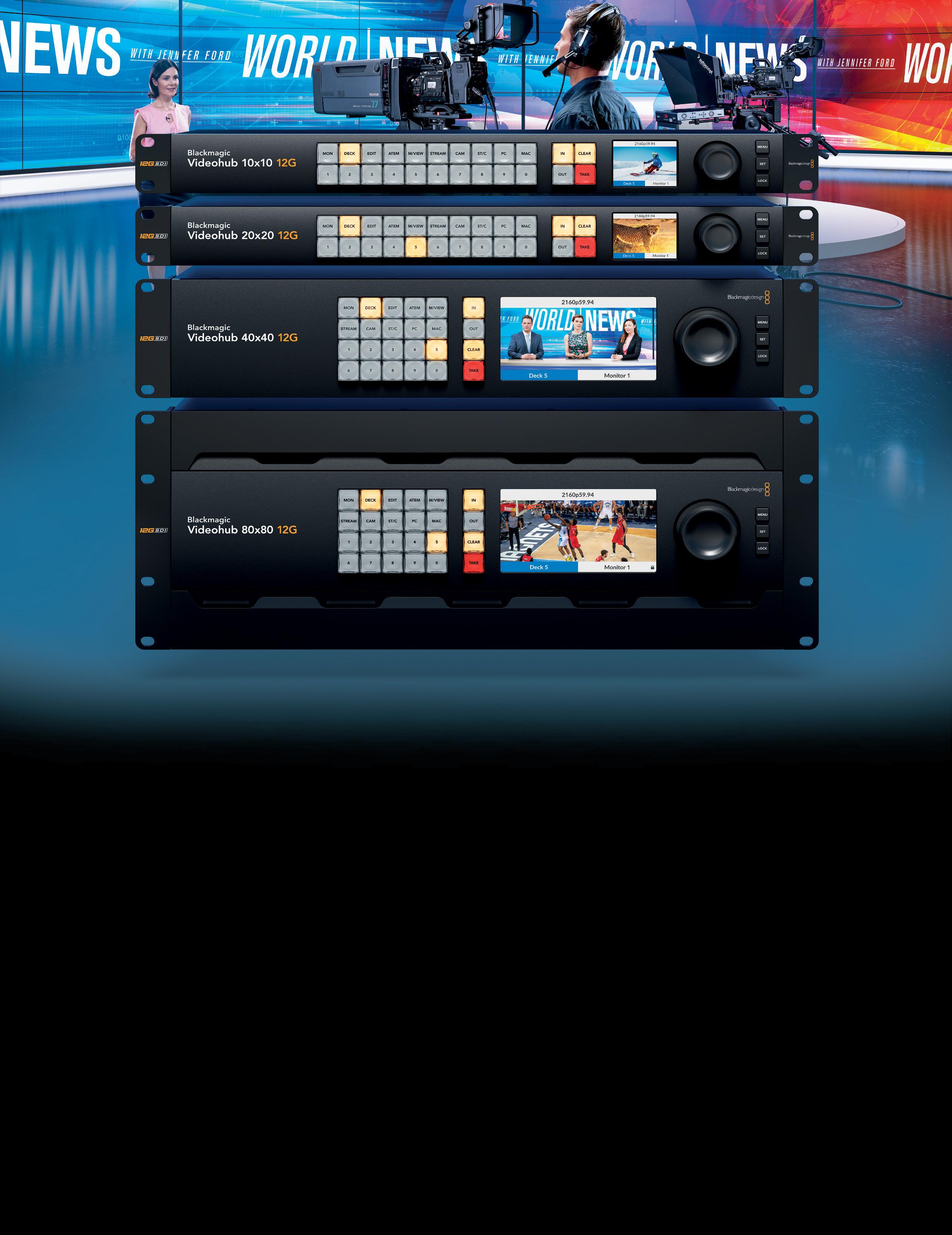
8 PRO | NEWS MARCH 2024
From left: Veer Passi, Group CEO of Kalaam, and Michael Martens, CEO of Riedel Networks.
HD and Ultra HD at the same time!
Blackmagic Videohub 12G-SDI video routers let you connect
Blackmagic Videohub routers support 12G-SDI so they allow you to connect and route any combination of SD, HD and Ultra HD on the same router at the same time. Plus they have zero latency so are perfect for live production and broadcast!
The built in front control panel lets you route video, so you get the perfect solution for live production racks that don’t have the space for extra hardware panels. The front panel features a spin knob for browsing, direct entry buttons for speed and an LCD for displaying labels. As the panel is built into the router, you can also see live
With a built in LCD, Blackmagic Videohub 12G can show you live video of all your router inputs! This means you can see all router inputs as live video before you change a route. There are also labels displayed below the live video to make it easy to identify the input you are viewing. What this means is you can scroll up and down the router sources in alphabetical order and see each input as live video.

Advanced 12G-SDI for SD, HD and Ultra HD Routing
Blackmagic Videohub 12G features advanced 12G-SDI connections which are multi rate so they support any SD, HD and Ultra HD video format up to 2160p60. Plus Blackmagic Videohub 12G supports routing any video standard on the same router at the same time. 12G-SDI gives you high frame rate Ultra HD via a single BNC connection that also plugs into all of your regular HD equipment!
Features Full SDI Re-Clocking
Videohub includes built in SDI re-clocking on every 12G-SDI input. SDI re-clocking regenerates the video signal for maximum video quality. This is extremely important because longer video cables degrade the signal. With SDI re-clocking all of the SDI devices in your studio receive a regenerated signal with improved jitter performance. That means longer cable lengths, and no drop outs in your video.
SRP excludes duties, shipping and sales tax.
Learn more at www.blackmagicdesign.com/ae
Content platform Million launches in MENA
Million, a content monetisation platform, has officially launched in the MENA region to revolutionise the way creators engage with their audiences and monetise their content. It empowers creators to take control of their creations and directly engage with their communities, and offers

INDIACAST ANNOUNCES LAUNCH OF DESI PLAY TV ON SHAHID
IndiaCast Media
Distribution Pvt Ltd, the content asset monetisation arm of TV18 and Viacom18, announced the launch of Desi Play TV, a South Asian FAST channel, on Shahid last month. Catering to audiences worldwide (except India), it offers free access to premium South Asian content without subscription fees.
a range of monetisation options including pay-perview, subscriptions, gifts and digital collectables. It ensures that creators are compensated for their creativity.
Founded by CEO Julien Hawari, Million is positioned as a social media platform dedicated to returning control to
creators. The initial rollout introduces a comprehensive suite of tools and features aimed at amplifying the social capital and utility value of content. Creators now have access to direct monetisation avenues, analytical tools and seamless transaction capabilities within the ecosystem.
OSN+ PARTNERS WITH 1001 TO STRENGTHEN IRAQI FOOTPRINT
OSN+ has entered into a strategic partnership with Iraqi streaming platform 1001. The deal will enable 1001 to offer OSN+ as part of its platform, offering more diverse content to its user base of two million users.
1001 introduced a single, all-inclusive subscription model in Iraq last month that offers its viewers an ad-free premium streaming experience at a monthly fee of USD 5. All 1001 subscribers will also have access to an OSN subscription. Subscribers have to undertake a few steps within the 1001 platform to activate their OSN+ app.
OSN+’s extensive collection will be seamlessly integrated into 1001’s subscription, which includes 3,000 hours of Iraqi content.
William Page, cofounder and Chief Strategy Officer and Legal Counsel at 1001 said: “This is a significant step in enhancing our streaming platform. With this deal, users will be able to search both the 1001 and OSN+ libraries within their existing 1001 experience, and once they find a movie or show they like, they can proceed to enjoy it either directly or with minimal friction on OSN+.”
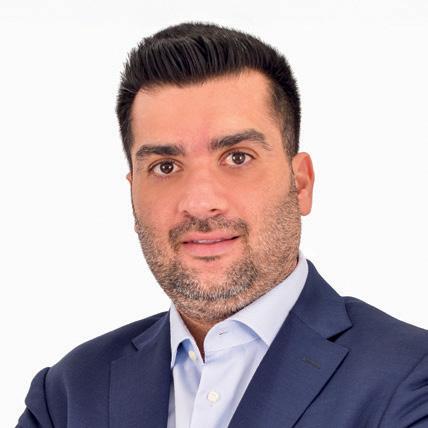
ZIAD ISSA TAKES OVER AS MEDIA CEO FOR IPSOS MENA
Ziad Issa has been appointed the new Media CEO of Ipsos in MENA, succeeding Elie Aoun, who steps down after a 32-year tenure at the company. In his new role, he will spearhead the Media Research business and Audience Measurement at Ipsos across the MENA region, and will focus on advancing the Media business through commercial activation and the introduction of new media services. He will report directly to Edouard Monin, CEO of Ipsos in MENA.
Issa brings over two decades of experience at Ipsos, having held various roles such as Media Research Manager, Director, Chief Client Officer and Chief Media Officer. His strategic thinking and dedication to client needs make him an ideal candidate to lead the Media business and drive further success for Ipsos in MENA.
10 PRO | NEWS MARCH 2024
Blue Engine Studios names new shareholder and Board Chairman
Blue Engine Studios, a major player in television production, has embarked on a new phase of strategic growth with the appointment of media veteran Nabil Soueid as the new majority shareholder and Chairman of the Board. Bringing over four decades of media experience, Soueid steps into this pivotal role following the departure of Hani Ghorayeb, who played a crucial part in establishing Blue Engine Studios as a prominent

player in the industry within a short span of time.
Under the leadership of CEO Ziad Kebbi, Blue Engine Studios is positioned to elevate
ACE SHUTTERS CIMA4U IN EGYPT
The Alliance for Creativity and Entertainment (ACE) successfully shut down Cima4U, an illicit streaming service operating from Giza, Egypt, in a significant triumph against content piracy in the MENA region. Cima4U, which operated a staggering 498 domains facilitating illegal online content streaming, has been a
key player in the piracy landscape. The site attracted more than 30m monthly visits from 11.6m unique visitors across its various domains. Offering a vast video on demand (VOD) library with more than 165,000 movie and TV series titles in Arabic and original versions, the illegal service significantly impacted all ACE members.
FOX-BRANDED CHANNELS IN MENA RENAMED
The Walt Disney Company Middle East has announced that all Fox-branded channels will be rebranded to STAR across the UAE and MENA, starting March 1. Notably, STAR Movies and STAR World will retain their names while receiving a refreshed look and feel.
its production of diverse scripted, unscripted and shortform content for both regional and international platforms.
Kebbi said: “The next phase
for Blue Engine Studios is about honing our focus on groundbreaking television programming. Nabil Soueid’s expertise is a significant asset as we continue to expand our creative horizons.”
Maintaining its exclusive partnership with John de Mol’s Talpa Studios, Blue Engine Studios benefits from a creative pipeline and a rich format catalogue, which includes the recent global sensation game show The Floor
TMC AND LISAN AI TO OFFER AI INTEGRATED MEDIA SERVICES
Media services company Total Media Cast (TMC) and Lisan AI, a prominent deep-tech Emirates company specialising in AI applications for languages, have partnered to redefine media content creation in the Arabicspeaking world. The collaboration
aims to integrate
Lisan AI’s advanced AI technology into TMC’s media services offerings, in order to streamline content creation processes and deliver higherquality media products to clients and audiences of Arabic-language channels.

11 PRO | NEWS broadcastprome.com
From left: Nabil Soueid and Hani Ghorayeb.
From left: Isam Ayyad, founder of Total Media Cast, and Noor Alasadi, CEO of Lisan AI.
Evision and Disney Star forge deal
Evision, the media and entertainment arm of e&, has joined forces with Disney Star in India to bring South Asian entertainment to the MENA region. The partnership kicks off an expansive array of content, commencing with a rich channel portfolio from Disney Star. Linear channels including Star Plus HD, Asianet Middle East, Star Gold and Star Vijay will now be accessible to UAE subscribers on elife, Switch TV, and its streaming platform, Starz ON. Disney Star’s linear channels will also feature in
INTIGRAL BRINGS SANDBOX CONTENT TO PLATFORM
Intigral and media firm Sandbox Group have signed a deal. According to the deal, Sandbox’s content will be available on Intigral’s OTT platforms, including STC TV and Jawwy TV, across MENA. The rollout will commence in KSA, followed by Egypt. Sandbox’s content, focusing on learning shows and arts and crafts videos tailored for children, will be fully localised in Arabic.

Asiana packages, catering to audiences in the UAE and the wider MENA region. Viewers will have access to the latest premium originals and a vast library from the Hotstar Specials catalogue,
specifically curated for South Asian audiences in the MENA region. Licensing rights for AVOD and FAST channels will be offered throughout MENA, offering viewers an extensive array of options.
Olivier Bramly, CEO of Evision, said: “This collaboration reaffirms our commitment to delivering the best in TV entertainment. Evision enables the audiences across multiple platforms and services to experience the best of South Asian entertainment and sports.”
Gurjeev Singh Kapoor, Head – Distribution & International, India, Disney Star, added: “The MENA region has shown great interest in our series and format shows, broadcast on our leading TV channels across languages.”
MEDIA CITY QATAR AND QFCA TO BOOST SECTOR
Media City Qatar (MCQ), a platform established to attract and regulate investments supporting Qatar’s media ecosystem, has inked a Memorandum of Understanding (MoU) with Qatar Financial Centre Authority (QFCA), the legal and tax arm of the Qatar Financial Centre (QFC). The collaboration aims to streamline the establishment of media
companies in Qatar. According to the agreement, QFC will register pre-approved media companies licensed by both QFC and MCQ. Details of registration and licensing will be recorded on the QFC platform. This partnership allows licensed companies to operate in Qatar in alignment with MCQ’s permitted activities.
QFC will handle necessary governmental procedures and taxrelated processes in accordance with Qatar’s legal framework, while MCQ will oversee compliance with applicable regulations for media entities. Additionally, the two entities will promote each other’s programmes and activities to ensure mutual support.
SHAHID TO ELBOW NETFLIX OUT OF TOP SPOT BY 2029
Netflix will lose its market leadership in the Middle East SVOD landscape to Shahid VIP, according to Digital TV Research. The region is projected to host 26m SVOD subscriptions across 13 Arabic countries by 2029, a spike from 14m in 2023. At the close of 2023, Netflix led the market with 3.8m subs, closely trailed by Shahid VIP with 3.5m and StarzPlay with 3m.
12 PRO | NEWS MARCH 2024
Olivier Bramly, CEO of Evision, and Gurjeev Singh Kapoor, Head – Distribution & International, India, Disney Star, at the signing ceremony.
Introducing Advanced Media’s Systems Integration and Corporate Team
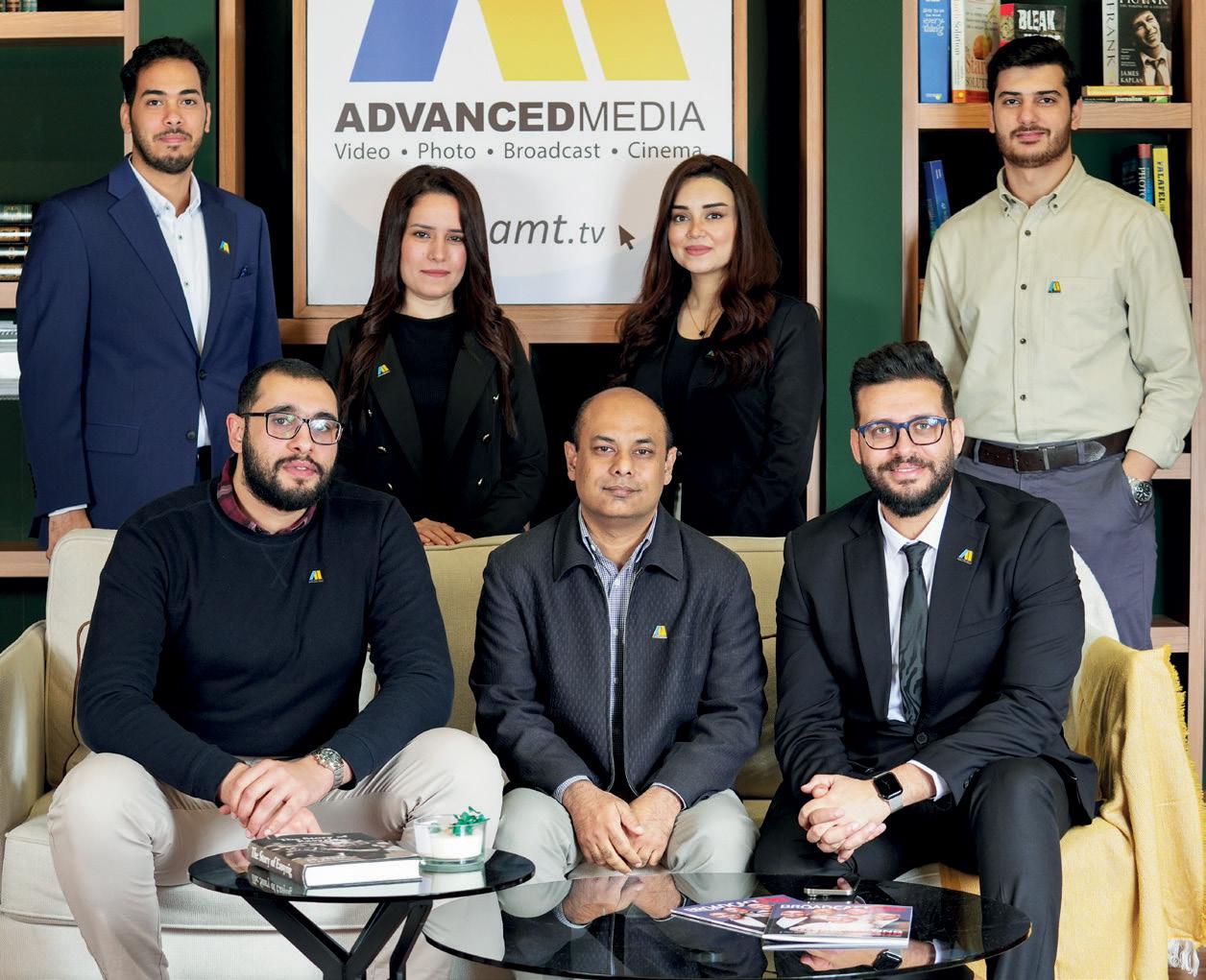
Founded in 2002, Advanced Media is more than a reseller and distributor of professional media equipment accessories. It is also an expert systems integrator with an experienced team recognised for a wide range of projects.
Advanced Media offers a raft of solutions and consulting services to the media and broadcasting industry. The systems integration and corporate team specialises in delivering endto-end services and cutting-edge technologies for all stages of the broadcast workflow, from infrastructure and contribution to distribution.
“Our system integration and corporate team comprises dedicated members with backgrounds in broadcast engineering and sales who handle every stage of the workflow, from consultation, pre-sales, solution architecture and project management to after-sales support, to deliver turnkey projects efficiently. This entails creating detailed
plans for the project timeline, expense estimates and project specifications, such as materials needed and crew requirements,” says Corporate Sales Manager Abdelrahman Elalfy.
Over the years, Advanced Media has built a wide range of systems including but not limited to file-based workflows with asset management system (MAM, DAM and PAM), workgroup-based non-linear editing systems, network and archive infrastructures, serverbased, automation-driven, multichannel playout systems, VR and XR production, radio and podcast setups, integrated news environments, outside broadcast vehicles and other mobile TV facilities, coding and multiplexing, fixed and mobile satellite Earth stations, project consultation and management services, service-level agreements and extended warranty support, international logistics and shipping, and CDM and site management.
Advanced Media’s team of experts provide customised solutions to meet the clients’ unique needs, with a focus on innovation and excellence. We strive to help our clients achieve their objective and stay ahead of the competition.
“Unlike other systems integrators, our team does not seek projects based on their magnitude or size but rather focus on curating projects for clients based on budget, demand and preferences. That affords us the flexibility to sometimes conduct three or four projects simultaneously,” says Fahad Hassan, Head of Professional Solutions.
Advanced Media has completed several prestigious projects over the years. Notable among them are a complete studio and MCR system for digital media platform Vuuzle Film Production; a turnkey educational studio for Islamic University of Madinah, KSA (2021); a complete broadcast system for a multi-purpose hall at Philosophy House in Fujairah (2022); a professional podcast setup for Abu Dhabi Media Office (2023); a complete post-production solution with edit suites and a remote editing system for Last Cut Media at Yas Creative Hub, Abu Dhabi; social media studios for new media platforms such as New Media Academy Nas Daily, Nas News and Edraak Media; and the migration of MCR vision mixer and a complete media asset management and archiving system for Al Dafrah TV (2024). Fahad Hassan concludes: “Our exposure to many diverse brands and our relationship with manufacturers and vendors established over the years provides us with a definitive edge and grants our client diverse options, setting us apart from other systems integrators.”
13 PRO | ADVERTORIAL

EMBRACING THE PERSONAL APPROACH
Streaming services acknowledge that personalisation is the cornerstone of an enhanced entertainment experience. However, its efficacy hinges on a raft of factors that shape its success or failure. In a roundtable hosted by BroadcastPro ME and BytePlus, regional experts gathered to talk about the personalisation journey in their organisations
14 PRO | COVER MARCH 2024

From recommendation engines running on single or multiple inputs to overwhelming amounts of data, and from personalisation to hyperpersonalisation, targeted content is fundamental to operating platforms. To digitally engage audiences, profile segmentation becomes vital, obtained through navigating the arcane world of AI, data analytics and recommendation logic. ‘Because it understands me’ is the underlying reasoning behind customers staying on a platform; therefore, curated content contributes greatly to longer stay times.
BroadcastPro Middle East, in conjunction with BytePlus, brought together a group of industry professionals last month to understand the impact and influence of hyperpersonalisation, harnessing and leveraging data, innovations in AI, and engagement and conversion to play. Chaired by Hasnain Gilani of BytePlus, the Enterprise Technologies division of ByteDance, the expert table consisted of Faraz Arshad, CTO,
StarzPlay; David Jacobs, Senior Manager – TV & Entertainment Media, Etisalat UAE; Dominic Farrell, CTO, Shahid; Jonathan Haysom, Vice President Home + Digital Entertainment, Etisalat by e&; Ryan Restell, VP Growth and Strategy, OSN+; William Sharp, CTO, Intigral; Sami Tabchouri, Strategist, blinx; Peter Van Dam, COO, Saudi Pro League Media House; Mais Halaseh, Director, Product Management, Weyyak by Zee Entertainment; and Hazel Wei, Product Manager, BytePlus.
With personalisation playing a big role in dictating customer churn, Gilani asked where each company stood in their personalisation journey and what processes were in place to drive it further.
There are multiple facets to personalisation, but it all begins and ends with content, said Dominic Farrell, CTO of Shahid, one of the region’s leading streaming platforms.
“Content is incredibly important because it drives relevance, which is one of the key KPIs in the content business.
Relevance drives consumption, which leads to customer satisfaction. This reduces churn. So when someone comes to your platform, how relevant is the content you’re showing them? How much do they want to consume it? This is where personalisation comes in. One of the big challenges with personalisation is that it is very reliant on the breadth and depth of your content catalogue. If you spend a lot of money on AI and machine learning algorithms but do not have the breadth and depth of content, you will end up serving people the same content.”
Running a platform across the MENA region also means one cannot broad-brush the number of languages and dialects, he continued. “We looked at geofencing trends, which is a basic form of recommendation but one with the most success. So essentially, what’s trending in Saudi? What’s trending in Egypt and what’s trending in the UAE? It is equally about the cadence of content on the platform. How often are you bringing new content? Because
15 PRO | COVER broadcastprome.com
The roundtable participants with the BytePlus team.
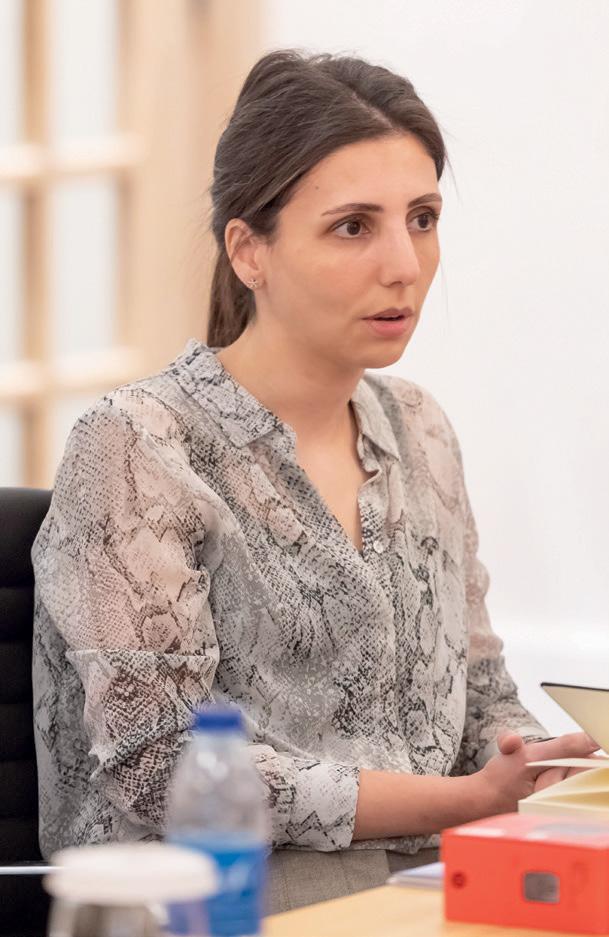

The UAE’s diverse population means recommendation engines need constant tuning, Jonathan Haysom said.
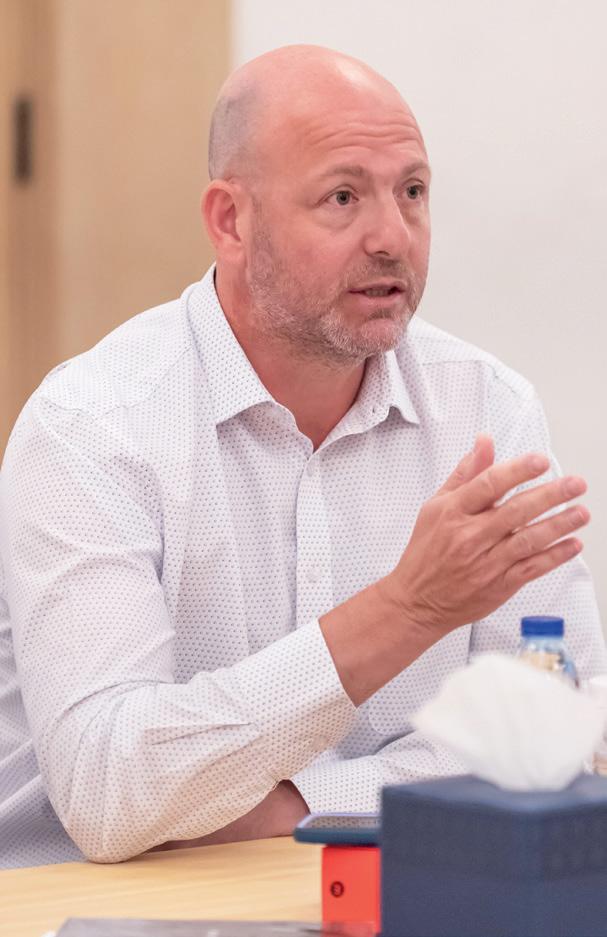
Nuanced content curation is key across OTT, IPTV and apps remarked David Jacobs.
a lot of people tend to watch the latest releases, although geo-fencing has been the most successful for us.”
StarzPlay CTO Faraz Arshad agreed, adding that for instance serving cricket in Egypt, where football is the most watched game, would result in churn. Offering context, he commented that StarzPlay began with an off-theshelf recommendation engine six or seven years back but discovered its editors offered better curation. One big challenge with automated recommendation engines is that “we don’t give them the time they require to evolve with your consumption metrics and discover the patterns across countries and regions”.
Today, the streaming service has adopted “a hyper personalisation approach where we do the things we are best at, and adopt multiple recommendation providers to embed their recommendations as well into our existing layouts, whether it’s by country, context, time-based, etc, including flipping the carousel … Our current strategy involves around 80% dynamically driven recommendations. with 20% room for editorial curations.”
It’s important to know who’s watching where, when and how – real-time data uplifts the experience
PETER VAN DAM, COO, SAUDI PRO LEAGUE MEDIA HOUSE
For e&, which caters to a much broader viewer base across the UAE as the leading telco in the country, the challenges and opportunities can be many, noted Jonathan Haysom of Etisalat by e&.
“With a viewership reflecting the diverse mix of ethnicities in the UAE, the dynamics posed to systems built for countries or operators with a much less diverse subscriber base means tuning

Relevance drives consumption, which leads to customer satisfaction and helps reduce churn, Dominic Farrell stated.
16 PRO | COVER MARCH 2024
Mais Halaseh of Weyyak stated that the platform takes a mixed approach to make recommendations.

and customisation is required. Trying to ensure the best fit for recommendation relevancy for someone who is not from the subcontinent diaspora can challenge systems and platforms that don’t allow flexibility or a proper ‘segment of one’ view. When it comes to content, we also use these systems to have a better understanding of what is important for us to have on the platform. If there are common traits
or threads we can see, we leverage that insight to promote and surface that content properly. It’s also extensively used for tuning our content catalogue.”
“Paving the way towards customer segmentation?” prompted Gilani.
“Exactly, segmentation is key to how we market,” said Haysom. “We may not be using ML modelling at the scale I think we could just yet, but we inherently use it to ensure we

onboard or pitch relevant content at relevant times to our customers.”
For David Jacobs of e&, that leads to customers seeing series and movies in the catalogue that they haven’t yet discovered themselves organically – less of ‘one to many’ and more of ‘one on one’ is the recommendation model he is hoping to evolve further. “It’s easy to push more Arabic series to somebody who already watches Arabic series. I want my engine to know who’s in front of the TV even when they haven’t set up their profile, kind of taking it to the next level. I think that’s where we need to move to.”
Echoing these sentiments, Ryan Restell of OSN also touted third-party recommendation engines for in-app personalisation. “We’re focusing on touchpoint personalisation this year, and we have seen that when we personalise from day one, our cancellations in the first month are much lower than when we have a blanket page that everyone sees.”
Focusing on AVOD content, Mais Halaseh of Weyyak by Zee Entertainment had a slightly different outlook. “We have a mix between geo-

17 PRO | COVER broadcastprome.com
Faraz Arshad says StarzPlay has taken a hyper personalisation approach, working with different recommendation providers to ensure greater success.
Bill Sharp from Intigral pointed out that no AI solution thus far was trained to Middle Eastern cultures and values.
Hasnain Gilani of BytePlus facilitated the discussion by asking thought-provoking questions on the personalisation strategies of each company.
fencing in addition to recommendations based on genres, sub-genres, original language and editorial curation,” she explained. “Because we cater to guest, registered and subscribed users, we are able to provide more accurate recommendations for both registered and subscribed users, as we collect data based on their behaviour and viewing history.”
Bringing the outsider view, Peter Van Dam of SPL Media House said it was in their mandate to make sure people around the world see the SPL and the Women’s League. “We personalise content. AI is important when we make segments for different platforms and partners to give unique highlights during league games.”
Intigral CTO William Sharp explained that recommendation engines do not solve all problems. “Lacking the
We have seen that when we personalise from day one, our cancellations in the first month are much lower
RYAN RESTELL, VP GROWTH & STRATEGY, OSN+
toolkit to manage the platform correctly, we tried to build our own engine with basic geography and genre-based viewership. We also facilitate our UI to bring meaningful results back to content marketing, to make informed decisions. The challenge is to integrate and ingest third parties’ and suppliers’ content and to recommend the best there. We need
a solution to pull that metadata out and then have a way to pre-moderate it.”
Sami Tabchouri of digital storytelling hub blinx, which primarily operates on social media platforms, remarked: “We have built a tech stack that we apply to identify behavioural patterns with the aim to put the best kind of content in front of the right audience at the right time. We have also capitalised on AI and extended reality in our content to create something visually unique and appealing for our users.”
Quantifiability of watch time and conversion to play is important for optimising business. The challenge is retention -- if the churn is reducing over time, you are engaging people better. Creating content requires strategy, time and approval.
“It’s important to know who’s watching where, when and
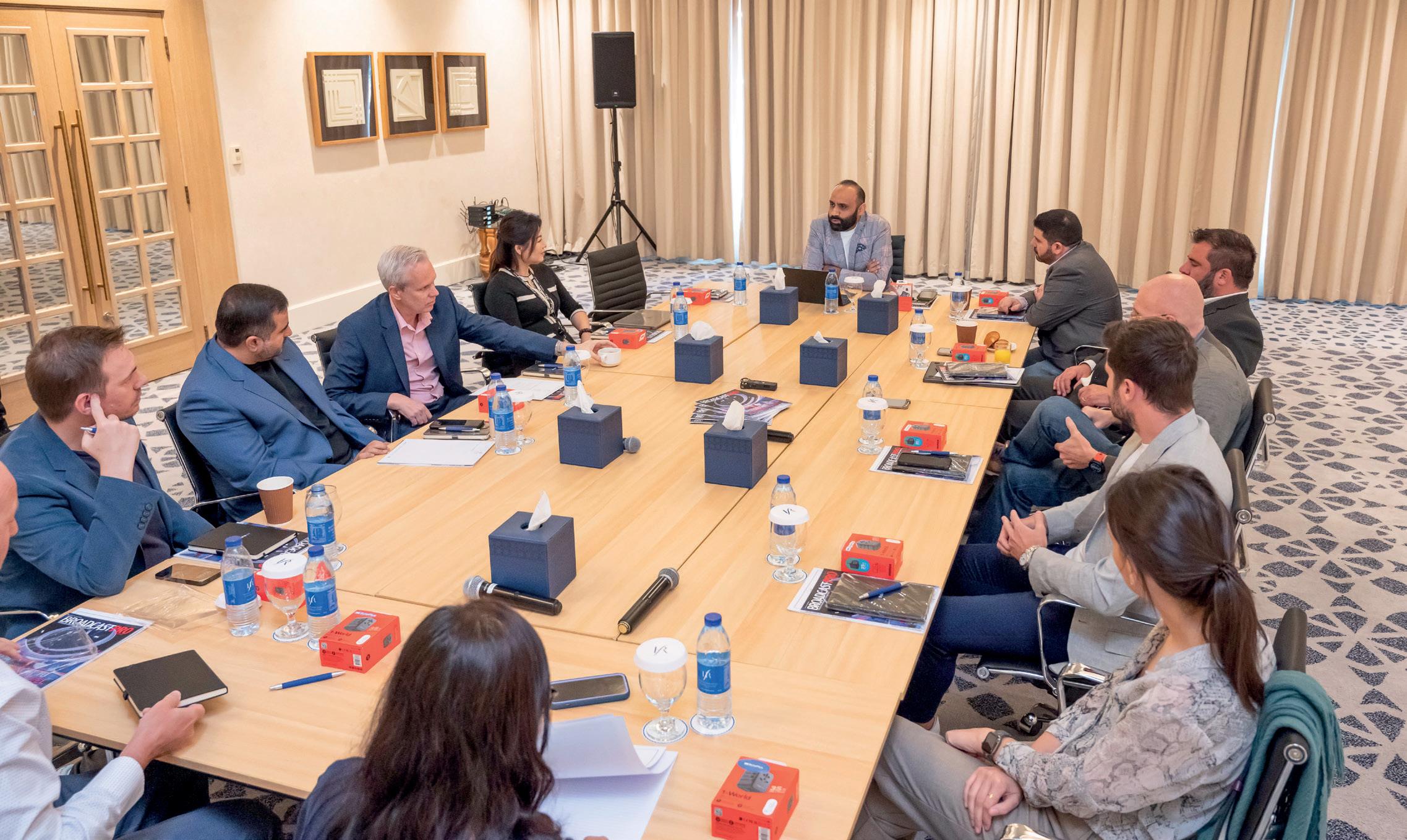

18 PRO | COVER MARCH 2024


how – real-time data uplifts the experience,” said Van Dam.
Jacobs added: “Whether it be reach or stay time, at some point translation to revenue is important.”
To measure effectiveness, the core metric is conversion to play. “Unless you have an extremely advanced algorithm, it’s only as good as the metadata fed into it,” Farrell pointed out.
With the pain points of recommendation engines and their effectiveness discussed, Hazel Wei of BytePlus opened the second half of the discussion by addressing some of the complexities.
Good infrastructural support is key to any successful recommendation engine, she began. “When we discuss recommendation, we are trying to match billions of content to one user.” Resource usage, speed and accuracy are paramount to calculating the probability of a user clicking ‘like’. “Engagement, on the other hand, is the harder part of recommendation, because it involves a chain of events that you presuppose a user participates in, such as clicking, sharing, leaving a comment, etc.”
User profiling, content profiling and flexibility are meaningful for the engine to learn and update in real time to create an impactful user profile. The search query, IP address and location are all very important for relevance. “If it’s close to me I feel more related to the content, tying back into Dominic’s point around geo-fencing and targeted content.”
Guest profiles are equally significant when you only have a cookie to rely on, making some amount of mapping essential. The need for content profiling and metadata tagging for
One of the big challenges with personalisation is that it is very reliant on the breadth and depth of your content catalogue
DOMINIC FARRELL, CTO, SHAHID
onboarding third-party content is a bit like labelling, Wei explained.
“In terms of actual profiling and collaborative filtering, the top 10 trends are very important. For cross-selling, because ads essentially impact the user experience, less is more in a way. All this needs to get done in quick time, and that’s why AI is so useful. AI is about uplift and so the infrastructure and framework become very important.”
Managing strategies to enhance watch time for less popular content is done to “incentivise the click-in”, Wei went on. As for the mean scale, it is adjusted flexibly according to different business tolerances for diversification, event view rates, tail content and so on. “Similarly for post-processing and pre-processing, the whole API is very customised to allow flexibility as and when needed.”
Using the interactive experience social media offers, and with shorts and reels changing the nature of apps, managing to integrate with any of the platforms is shifting the nature of operations. Curated content can be uploaded, with the option of
19 PRO | COVER broadcastprome.com
Peter Van Dam remarked that AI is important especially when making segments for different platforms and partners to give unique highlights during league games.
Ryan Restell commented that OSN’s focus this year was on personalisation at touchpoints.

watermarking and showing the company name or product. With moderation being key, strategising becomes tricky.
“There is AI in moderation, but I don’t believe there’s anything trained to the cultures and values of the Middle East,” remarked Sharp. “We want as many views as we can, we want people to upload it to the platform easily, but how do we manage that? And then it comes back to your trusted influencers, where you have a level of verification, and then you need some level of moderation.”
Moderation in AI is an interesting one, but the compute power and timeliness aren’t there yet. “There are different ways we can be compliant to local needs, but AI and ML disruption in this space is still nascent,” commented Haysom. “In other parts of the world, where these tools are seeing some early adoption, they’re being tuned on data points and learning from footage that represents that particular local population mix and its censorship or sensitivity requirements, so it’s a little more accurate for those regions.
Getting those basic needs tuned for
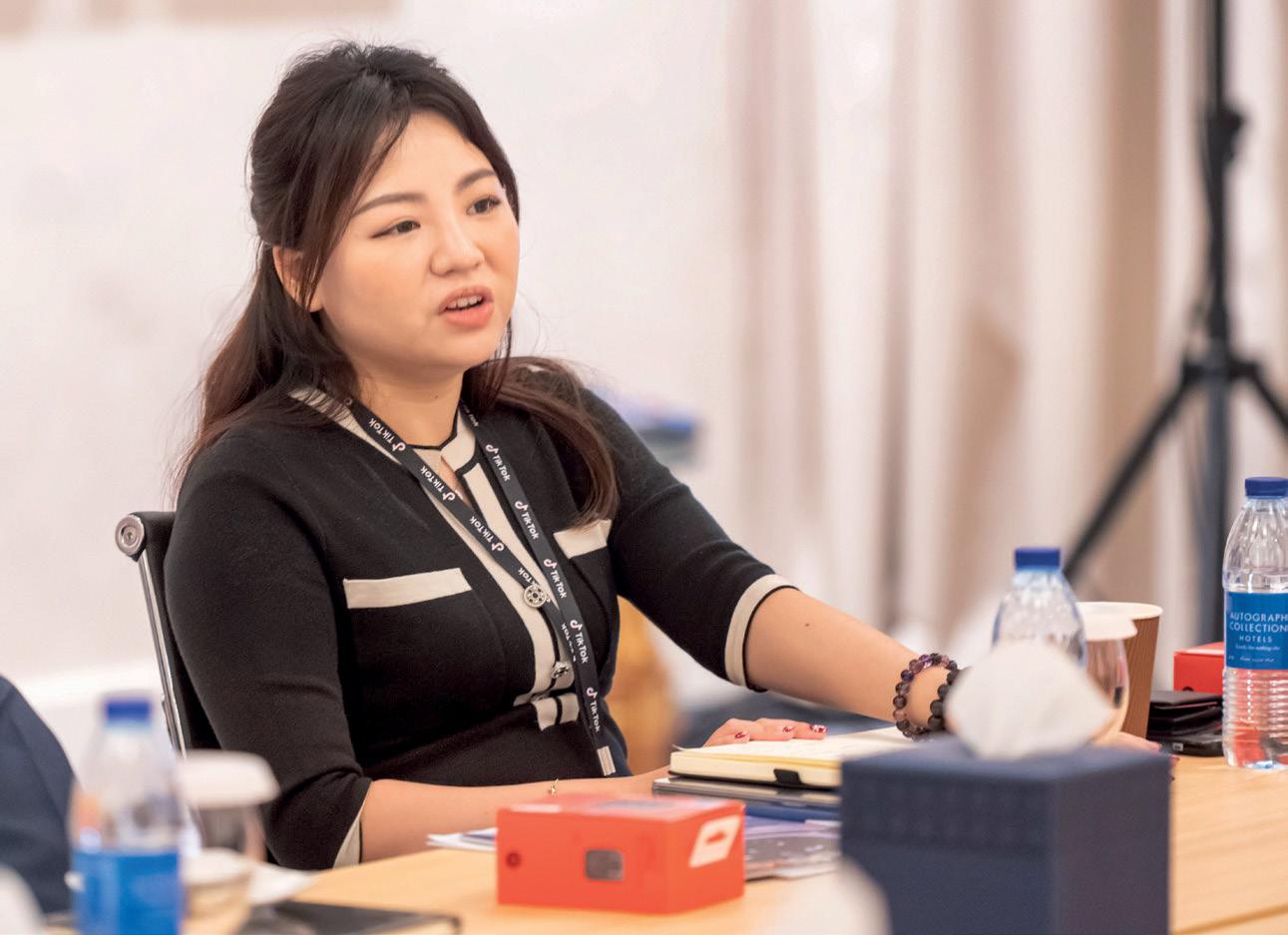
this region is very important before they can be used with confidence.”
Recommendation infrastructure demands a model that can drive the right kind of traffic. It depends on the amount of investment and where operators wish to aim their internal tech resources. With varying ideas on transition challenges, Al Halaseh said that Weyyak had its own internal recommendations because of iteration “when you don’t have Arabic speakers working on the recommendation engine outside”.
For everyone else, the challenge is to identify the optimal path
Our current strategy involves around 80% dynamically driven recommendations. with 20% room for editorial curations
FARAZ ARSHAD, CTO, STARZPLAY
toward a metric that combines hybrid hyperscaling and hyperpersonalisation. Essentially, all are looking to streamline the user experience, helping to minimise the steps from powering on to playback and ensuring that the relevance resonates with the end customer.
Everybody has the same business challenge, “but the difference is the ways in which it is nuanced in content creation, OTT, apps, TV services and IPTV”, remarked Jacobs.
Presenting accurate recommendations is critical, with multiple services and ways to adapt to aggregate content. To offer the right content, everyone is looking for the best solutions and there’s room for collaboration. “Ninety-eight zettabytes of content are consumed globally, daily,” commented Tabchouri. “That’s one followed by 21 zeros! So the pie is pretty big and in order to win in the content space today, collaboration among creators and entities is key.”
The appetite for content consumption is huge, and as operators come together to add value, the industry can only grow.

20 PRO | COVER MARCH 2024
Sami Tabchouri stated that blinx uses a tech stack to help identify viewer behavioural patterns.
Hazel Wei addressed some of the concerns raised by some of the panellists in the first half of the discussion.


Wednesday 22 DUBAI / UNITED ARAB EMIRATES SILVER SPONSOR © 2024 CPI Trade Media. All rights reserved. Vijaya Cherian +971 4 375 5472 vijaya.cherian@cpitrademedia.com Award Nomination Enquiries Know Celebrating Excellence, Honouring Innovative Manufacturers in the Broadcast Sector IN ASSOCIATION WITH 21- 23 MAY 2024
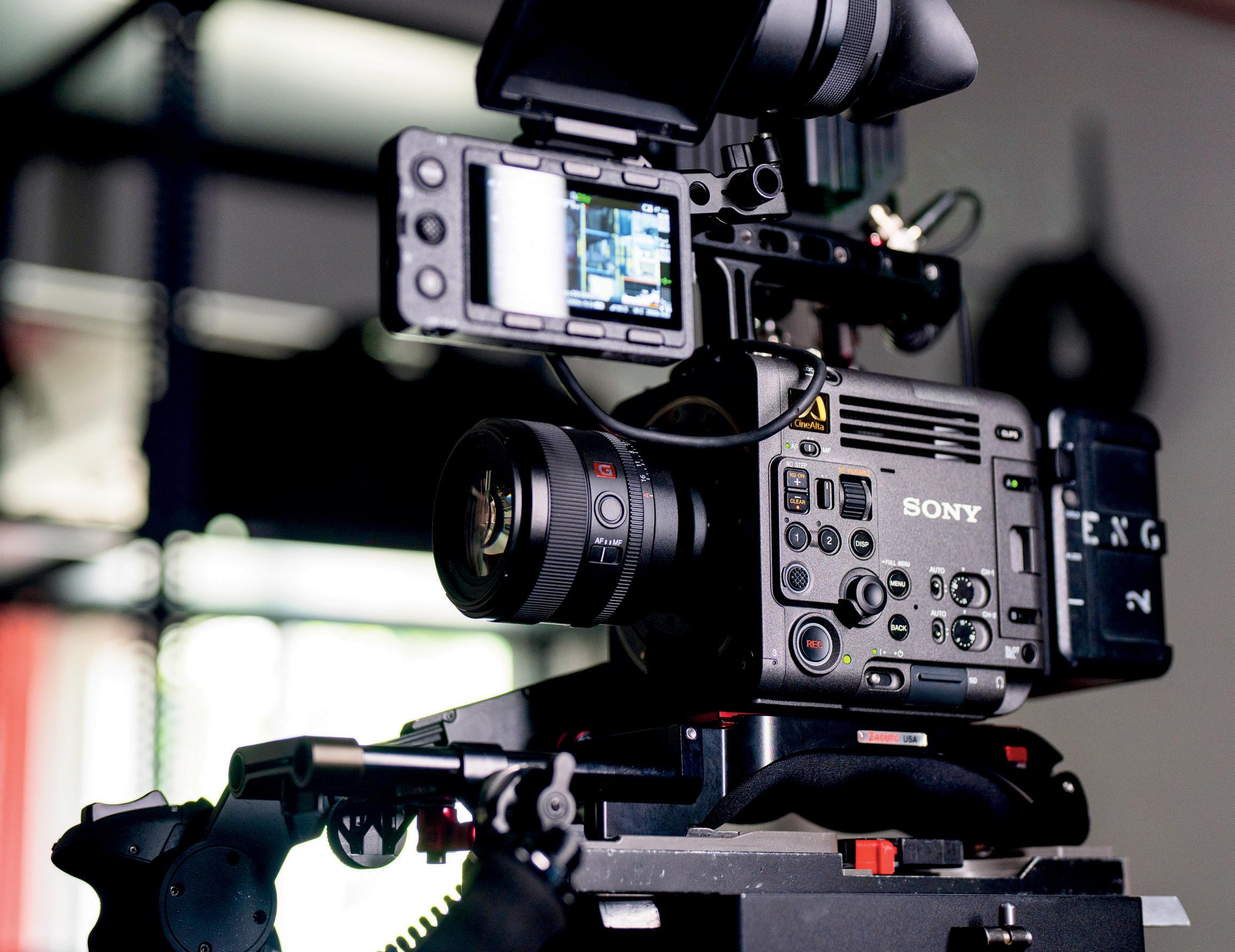
SHOOTING STAR
The small and compact Sony Burano packs a punch with its myriad features, including an auto-focus function that makes it wellsuited for solo shoots, says Dubai-based DoP Timothy Fare-Matthews
The Sony Burano is the newest kid on the block in the Sony Cineline family. It might be Sony’s most significant move since the introduction of the FX6, which really revolutionised how I worked and managed to execute a lot with a little.
What do I mean by a little, exactly? Well, our team members wear many hats on a production. We rarely have a first or second AC on set. We use the auto functions, we like having as little kit with us as possible, and the nimble, lean approach enables us to react quickly to the unpredictability

22 PRO | REVIEW MARCH 2024


of the production industry.
The Burano hits the market this month, and I won’t be surprised if it becomes one of the most popular cameras by the end of 2024 owing to its solo shooting benefits. Before I dive into its features, it’s important to understand why the Burano was destined for launch now, and why I feel it will dominate the premium production market moving forward.
In recent years, Sony has made impressive strides in the feature market, evident in its top placement in the Cinematography Nominees Camera Manufacturers Chart at the Emmys. Why is this important? Well, it demonstrates that Sony is now executing at the level where the top people in the industry play, yet it still caters to something a student would use, like a small ZVE-10. The company has invested heavily in cascading technology and content-capturing capabilities, from its flagship models to more affordable equipment, making this ecosystem highly relevant.
But the gap has always been quite large. I always used to struggle as a DOP going from something like an FX6 or FX9 to a Venice, because the latter, like any equivalent camera, requires an entire infrastructure to operate.
The Burano completes the Cineline puzzle, bridging the gap from Alpha/low-end Cineline users (where all the handy ergonomics exist) to the flagship cinema-level Venice 2. It’s as if the Venice 2 and the FX6 had a child, capable of outperforming each in certain aspects.
Out of the box, it feels incredibly well-built. It looks and feels like a baby Venice. If you are an FX6 user, you will instantly recognise many similarities with the button layout and noticeable features on the smart side of the body. It has a pretty decent future-proof 8.6K full-frame sensor. Though not
This camera accomplishes tasks faster at arguably better quality with fewer crew
TIMOTHY FARE-MATTHEWS,
DOP AND CO-OWNER, FIRST AND TEN PRODUCTIONS
identical to the Venice 2 sensor, it’s designed for ergonomic use with auto features, which we’ll explore shortly.
However, you will experience some drawbacks in the resolution area. When I get my hands on any new camera, I first head straight to the recording formats and frame rates menu to see what I have to play with. The Burano supports full-frame 8.6K at 30 fps, full-frame cropped (only slightly) at 6K at 60 fps, Super35 5.8K and Super35 cropped 4K at 120 fps. Depending on
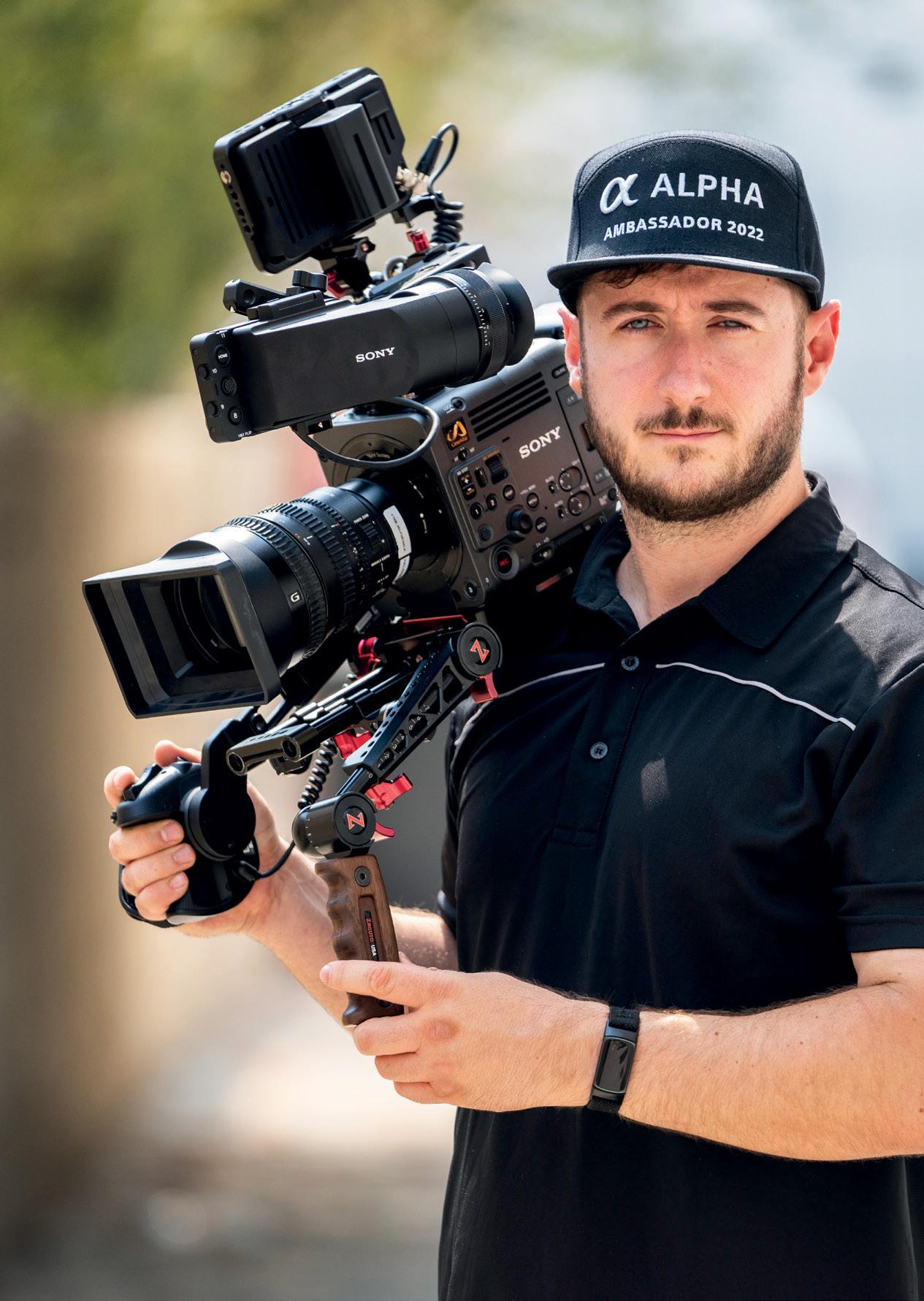
23 PRO | REVIEW
Timothy Fare-Matthews road tests the Sony Burano.
The Burano’s main selling point for me is its auto functions. It’s like having a Venice that can auto-focus
TIMOTHY FARE-MATTHEWS, DOP AND CO-OWNER, FIRST AND TEN PRODUCTIONS
future firmware updates, my guess is you wouldn’t rush out to get this for its frame rates, but if you’re not too concerned about the high speed then it certainly makes up for it in other areas.
I used the Burano for a recent production, shooting in low light at La Perle, Habtoor City in Dubai, and despite the challenge low-frame rate options Super35 mode gave me, I still got a very stunning image with very little noise visible. Anyone who has attended the theatrical productions at La Perle will be familiar with how dark and challenging that environment is to capture. What the camera lacked in terms of frame rate and resolution options, it made up for with its incredible ergonomic features and detail.
The lighting at the event varied tremendously, so the fact that the Burano offers 16 true stops of latitude really helped us play with and expose the footage correctly later in the edit. What helped us again in terms of ergonomic features was the 16-bit XOCN codec (Sony’s RAW). I have worked with XOCN-XT from the Venice before and was familiar with how well that performs, so I was expecting a drop, as this only delivers an XOCN-LT codec (the Venice does XOCN-ST and
XT). For what I was producing and for the Dubai market we rarely feel the need for XT, so the fact that this gave me an incredibly sharp, well-captured, clean-looking image was impressive.
It uses CF-Express Type B cards, commonly used by other cameras and brands in the market, thereby making it a more affordable memory solution compared to the Venice AXS cards. How much information you get with LT can be clearly found on the charts at sonycine.com. At 4K XOCN XT (24p) you get 965MBPS, compared to 389MBPS at LT, slightly surpassing the XAVC Class480 Codec familiar from the Sony PMW-F55 while retaining the flexibility of Sony’s RAW (XOCN codec).
Like its siblings the FX6 and FX9, the Burano features an impressive internal variable ND. If you have never used one, you will find it very difficult to go back to a life without it. To have a variable ND on a camera with a sensor of this size is very impressive. It goes from ND 1/4 all the way up to 1/128, comparable to 2 to 7 stops difference.
One really useful feature is the IBIS (In-Built Image Stabilisation). I used this with the Sony G Master glass, so naturally I would expect it to perform very well. The FX6, FX9 and Venice do not have this feature, which again makes the Burano a camera of its own class.
But the question is: does the industry require this? It has its pros and cons. On the one hand, it provides solo shooters with a more practical, easier way to shoot handheld content. On the flip side, having a sensor capable of IBIS means it isn’t locked, which restricts the ability to rig or get stable footage if it is mounted on something with intense vibrations (for example, a race car). But if people are doing lots of challenging shots like that and working on incredibly high-end projects, they have the Venice 2 and the Rialto to go to.
One standard the Cineline offers, which I am happy also exists in the Burano, is its dual base ISO of 800/3200, essential for two native clean sensitivity modes, ideal for low-light shooting. The La Perle shoot was incredibly dark, so I pretty much had the camera on 3200 the entire time. Rarely did I need to add extra gain to the image. This is why I think the Super35 Scan mode behaved so well, as the image is incredibly clean.
The Burano’s main selling point for me is its auto functions. It’s like

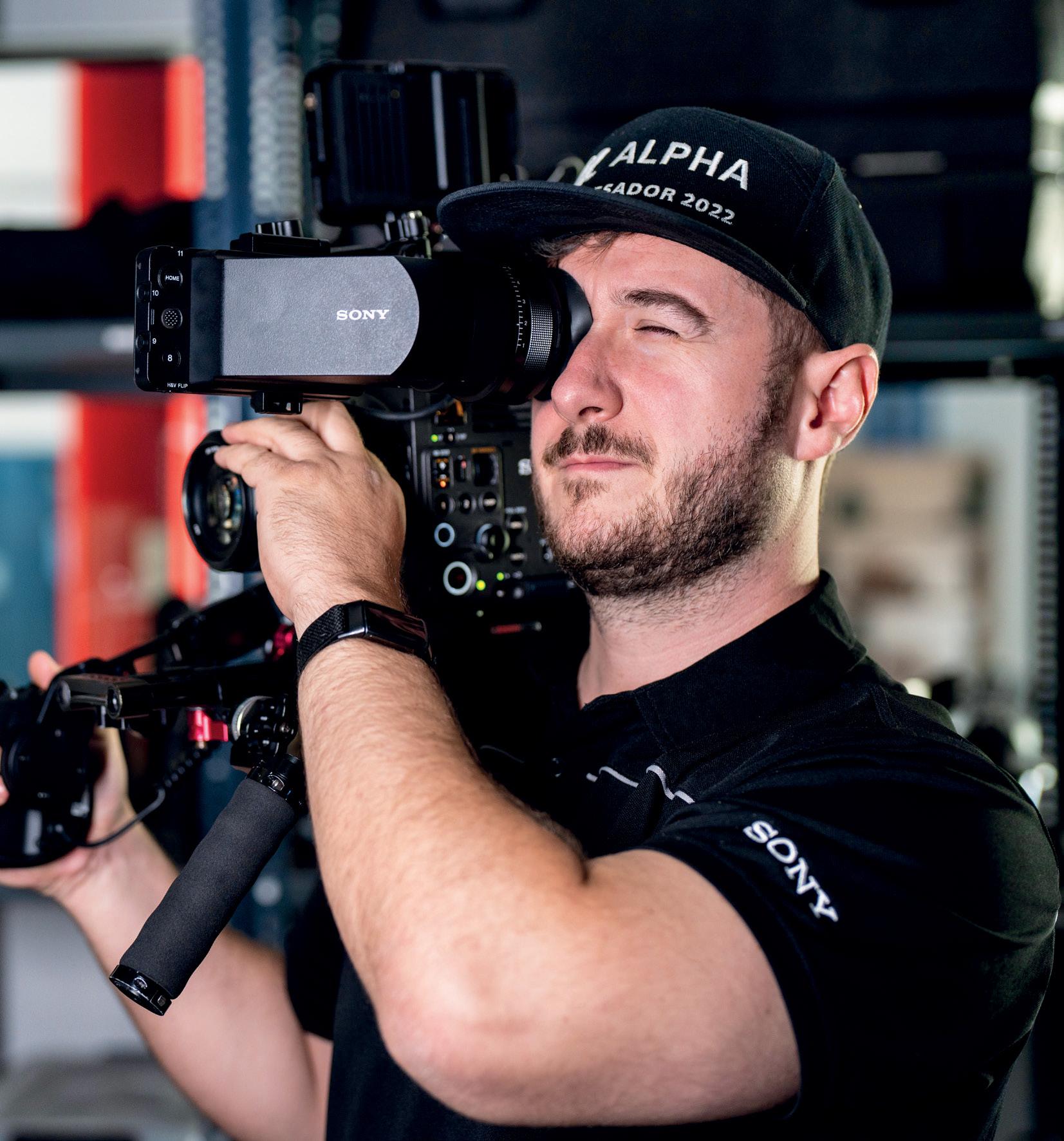
24 PRO | REVIEW MARCH 2024
having a Venice that can auto-focus. Despite scepticism about using auto in feature-level or commercial work, I urge you to try it. It would have been impossible for me to capture that look and feel at La Perle on my own without this technology. But to fully maximise its potential, you need to use lenses catering to AF and E mount. The Burano comes with a standard PL mount which easily comes off with a few screws, and what lies beneath is a locking Sony E mount with autofocus capabilities,
simplifying operations for solo shooters like those who would use an FX6. One oversight on Sony’s part is that the PL metadata sensors are exposed once the mount is off. An easy fix is to put some tape across it to ensure protection while you’re out and about shooting. The E-mount and AF functions open up a vast array of possibilities that would typically require monitors, cables, FIZ units and a first AC. I recently filmed a walking piece-to-camera with the Burano using
a 50mm 1.2 on an Easyrig, nailing the take in one shot without focus issues.
The viewfinder, with its touch tracking function, also significantly eases camera operation. In a scenario like at La Perle where you have someone flying around the room, you’re able to easily track them correctly by keeping them in the frame. You can simply touch the viewfinder screen on the subject you want to focus on. Keep the lens on AF, and the camera does the rest. It also has modes in order to speed or slow down the feel and pull of the focus.


As content consumption increasingly shifts to mobile phones and technology simplifies shooting, the question is whether we still purchase cameras solely based on quality, even for top-tier Netflix-style productions. I would argue, no. Jamie Lin, an early adopter of the Burano, believes each camera serves its purpose: “The Burano is perfect for high-resolution projects where mobility and time are of the essence. It may not replace a Venice 2 on a feature film set, but for documentaries, music videos and commercials, it’s unmatched.”
This camera accomplishes tasks faster at arguably better quality with fewer crew members, freeing up budget for other production elements. We’ve all experienced delays waiting for crew to change a filter or adjust focus. Those days are over with the Burano. In conclusion, the Sony Burano emerges as a versatile powerhouse, seamlessly blending high-resolution capabilities with intuitive auto functions, streamlining production workflows and setting a new standard for efficiency and quality across diverse projects.
25 PRO | REVIEW
TIMOTHY FARE-MATTHEWS IS A DOP AND CO-OWNER OF FIRST AND TEN PRODUCTIONS IN DUBAI.
Ask yourself: when did you last observe teenagers in your household grab the remote control and browse the Electronic Program Guide (EPG) to select a channel on satellite or cable TV, instead of just watching it straight from their tablet or smartphone?
The generation gap is massive. The age-old model of linear TV that was once the back-bone of our media consumption is fading into obsolescence. The shift toward streaming services, compounded by changes in consumer behaviour, is significantly disrupting the broadcast industry.
In the US, cable television has become a battleground of the underdogs, where the winner is the service that loses the fewest subscribers each quarter and powerhouses like Comcast find themselves in a fierce battle against competitors such as Charter Communications. It’s a market where, according to Ampere Analysis, 18- to 24-year-old adults consume 94% of their videos on-demand and only 6% on linear TV. No wonder Disney is contemplating divesting parts of ESPN to fund its transition to streaming services.
In Europe, things are no better. ARTE
The evolution of linear TV to a new digital-centric model is unavoidable and necessary
channel dreams of itself as a future European Netflix, while the RTL Group is prioritising scaling up its subscriber base to appeal to brands and advertisers with its TV Now and Videoland services. In the meantime, traditional broadcast advertising revenues are dropping rapidly and FAST channels are still trying to figure out a path to profitability.
In our MENA markets, the writing is on the wall: 60% of the population is under 30 and the median age is 27, eleven years younger than in the US and 17 younger than in Europe. The cost of mobile broadband subscriptions may remain excessive by international standards, but Wi-Fi hotspots are plentiful. Younger generations are already on the move and ‘cable-cutting’ from a cable many have never had.
BROADCAST 2.0: A CALL TO ACTION FOR THE DIGITAL AGE
Adapting to over-the-top and IP-based services is no longer optional but essential for broadcasters, if they want to remain relevant in this new age
This shift signifies more than a change in viewer preference – it heralds a revolution in how content is produced, distributed and consumed, and how advertising is served within this new digital landscape. Brands are eagerly pursuing digital audiences, enticed by the precision and measurable engagement of online advertising platforms that they have become used to these past two decades.
Adapting to over-the-top (OTT) and IP-based services is no longer optional but essential for broadcasters, especially those publicly funded. To remain relevant, they must reach consumers, subjects and citizens where they consume content. Such an adaptation demands a radical overhaul of legacy OTT platforms, transforming them from secondary considerations to the forefront of broadcasters’ strategy. These platforms must be enhanced to support advanced, data-driven customer engagement mechanisms critical to retaining consumer attention and generating the revenue necessary to produce genuine, captivating content.
To be relevant, next-generation Broadcast 2.0 OTT platforms must plug into the existing content management systems that drive modern broadcast operations. Legacy archives, daily produced media assets and their associated metadata sets must stay addressable and accessible to distribution systems. Automated workflow engines are required to streamline distribution in a multi-platform world where media asset footprint (MAF) across OTT and social networks has become key to consumer attention and associated revenues, be these advertising- or subscription-based.
As we navigate this brutal transition, the industry is tasked with comprehensively updating its digital infrastructure. This evolution requires more than just technological innovation. It necessitates a complete re-evaluation


26 PRO | TECH MARCH 2024


of how content is produced, managed, delivered and monetised. Broadcasters must implement solid data strategies to drive these next-generation content distribution platforms. Developing new target operating models (TOM) is no easy task. It is the art of digital transformers and requires the buy-in of all stakeholders to determine what capability gaps remain. Broadcasters also have to focus on creating platforms driven by editorial integrity, leveraging AI-driven content curation and using data analytics to customise campaigns according to viewer preferences and behaviours, to meet the requirements of contemporary digital advertising marketplaces.
The underlying principles are clear: consumer data is an invaluable asset in the digital age, too precious to be monopolised by global tech behemoths like Google, Facebook and Netflix. To reclaim and maintain consumer trust, broadcasters must concentrate on delivering content that truly resonates with their audience, coupled with advertising that is both relevant and
valuable. Programming needs to engage viewers by addressing their interests or connecting with them, ensuring it captures and retains their attention.
In addition, schedulers must milk content release windows across the TVOD (transactional video on demand), SVOD (subscription video on demand), AVOD (advertising-supported video on demand) and FAST (free ad-supported streaming television) continuum. Moreover, they need to do their best to guarantee a return on investment on the long tail of their catalogues. Similarly, advertising must be

pertinent and add value to the consumer experience. As with web advertising a decade ago, a tailored approach is critical to satisfying the demands of brands and advertisers that require concrete, quantifiable engagement with their target audiences.
The future of broadcasting lies in the strategic implementation of hyperpersonalisation in both content and advertising. Customising the media and marketing messages to align with individual preferences and behaviours will create a mutually beneficial scenario for both brands and consumers. This strategy not only enhances viewer satisfaction but also unveils new avenues for revenue, laying a solid groundwork for the transition to Broadcast 2.0.
The evolution of linear TV to a new digital-centric model is unavoidable and necessary. As the broadcasting sector evolves, leveraging cuttingedge technology and data analytics will be pivotal in delivering a more personalised, engaging and effective viewer experience. This shift is a significant challenge and an extraordinary opportunity to redefine the essence of broadcasting for the new digital era.
SAMMER ELIA IS SALES AND BUSINESS DEVELOPMENT DIRECTOR AT VIACCESS-ORCA, AND NICOLAS HANS IS A PARTNER AT BROADCAST SOLUTIONS.

27 PRO | TECH
WHAT LIES BENEATH
When Turkish DoP Murathan Yildiz joined a group of ten professional underwater photographers and technical divers from across the globe for a five-day expedition in Gallipoli, Turkey to capture some of the shipwrecks that lie beneath its depths, he turned to the Blackmagic Pocket Cinema Camera 6K


28 PRO | CASE STUDY MARCH 2024
The world is full of wonders, including historical and cultural heritage sites like the Egyptian Pyramids and the Roman Colosseum. There are also places out of the ordinary, reserved for the most intrepid of travellers searching for a once-in-a-lifetime experience.


In northwestern Turkey, the town of Gallipoli conceals one such place, with relics from the First World War beneath its seas. Around 60 shipwrecks from the Australian and New Zealand Army Corps, who fought in the 1915 Battle of Gallipoli alongside British, Irish and French forces, lie here. For decades, this underwater area was inaccessible due to active munitions. However, since 2022 the Turkish Ministry of Culture has permitted technical and recreational diving in this protected zone.
Murathan Yildiz, founder and director of photography (DoP) at Dikey Ajans, embarked on an extraordinary quest to film the Gallipoli shipwrecks. The project, commissioned by the Directorate of Gallipoli Historic Site, involved ten professional underwater photographers and technical divers who came from different parts of the world for a five-day expedition. The documentary was shot on the Blackmagic Pocket Cinema Camera 6K, with post-production completed in DaVinci Resolve Studio.
“Our goal was to shed light on a hidden chapter of history, making it more accessible to the general public. While this is a documentary, I wanted it to have a cinematic aspect with touches of drama, befitting the historical significance of the site,” explains Yildiz.
The camera, encased in a Nauticam underwater housing, was paired with specialised optical domes to correct light beam angles. Four sets of 12,000 lumen Archon DM60 underwater lights were used primarily for lighting, mounted on floating arms.
“Underwater filming presents
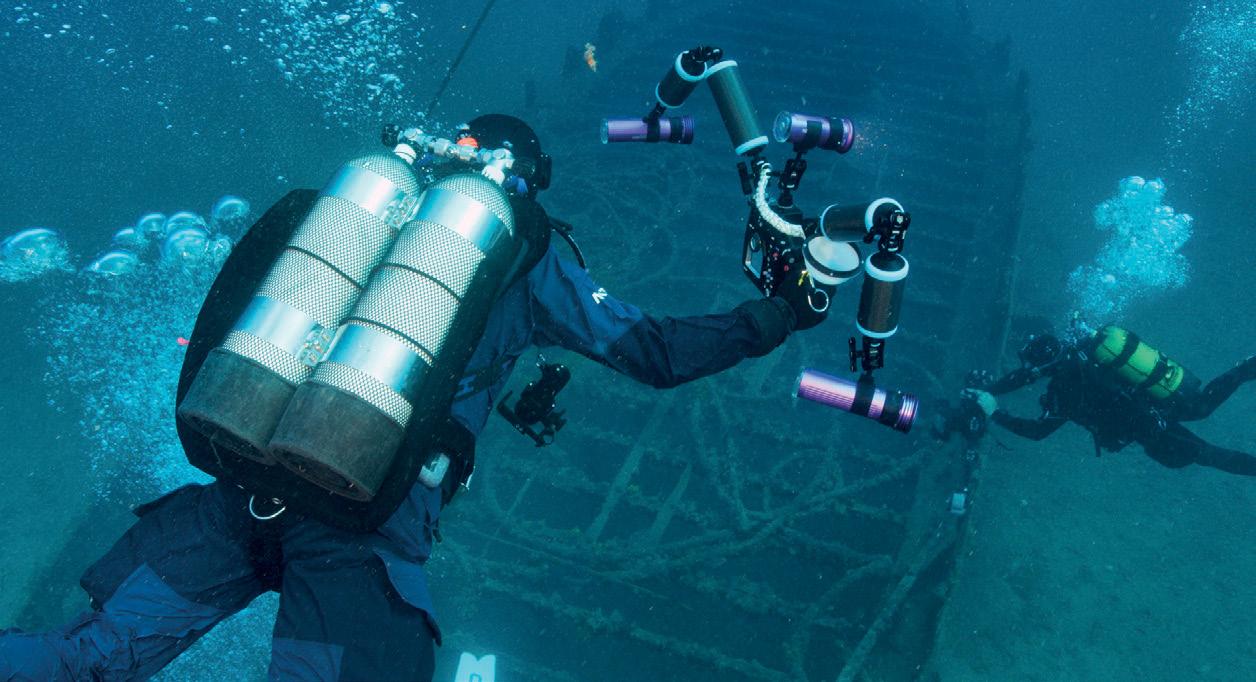

While this is a documentary, I wanted it to have a cinematic aspect with touches of drama
MURATHAN YILDIZ, FOUNDER AND DIRECTOR OF PHOTOGRAPHY, DIKEY AJANS
unique challenges,” notes Yildiz. “Light and colour change dramatically with depth. Without proper lighting, the environment turns monochromatically blue or indigo. Red light is absorbed first, vanishing at depths of less than 15 feet, making red objects appear greyish. As we go deeper, orange and yellow colours then follow, fading away at around 25 feet and 35 feet respectively. Green light persists a bit longer but is absorbed around 65 feet.”
The shortest wavelength, blue
29 PRO | CASE STUDY
In northwestern Turkey, the town of Gallipoli conceals many relics from the First World War beneath its seas.
The camera’s dynamic range, combined with the dual native ISO sensor, were crucial in realising this documentary
MURATHAN YILDIZ, FOUNDER AND DIRECTOR OF PHOTOGRAPHY, DIKEY AJANS
light, penetrates the deepest, reaching down about 200 feet before being absorbed. This selective absorption of light not only alters the visual experience of divers but also influences underwater photography and the appearance of marine life.
The documentary not only captures the wrecks, but also portrays the technical divers’ experiences and the marine life of Gallipoli’s seabed. As such, the production favoured the Pocket Cinema Camera for its superior colour reproduction in
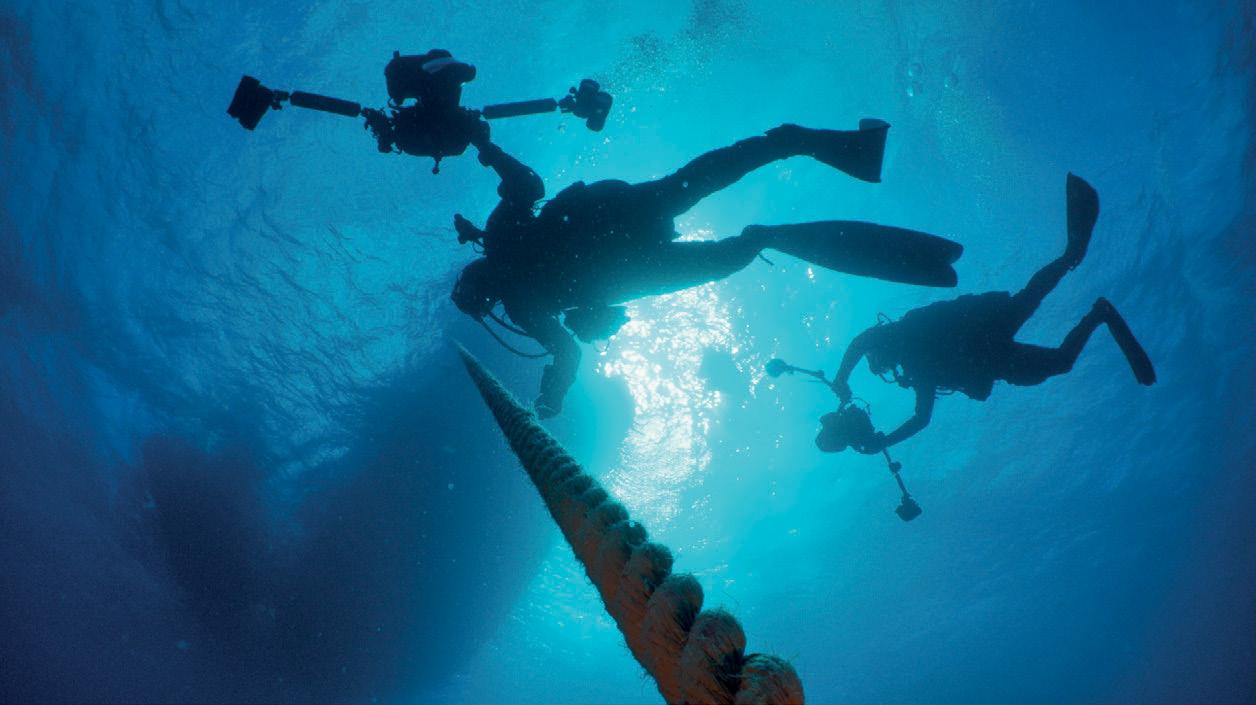
these challenging conditions.
“The camera’s dynamic range, combined with the dual native ISO sensor, were crucial in realising this documentary, as we had to counterbalance overexposure in many plans and needed as much latitude as possible heading into post to achieve the cleanest looking image. Balancing white levels was also essential, as we had to compensate for colour loss. Depending on the light source and depth, I’d adjust the white balance to ensure accurate colour representation.

“Acquiring in 6K at 50fps using Blackmagic RAW 8:1, we also took advantage of the camera’s off speed recording function. That meant we could switch to shooting between 25 and 50fps using the HFR button, allowing us to capture breathtaking slow motion.”
Mastered and delivered in 4K, postproduction relied on a DaVinci Resolve YRGB Colour Managed workflow, with features like the Colour Warper allowing a smoother transition in colour shift.
Yildiz, also a lecturer at Istanbul University, speaks about his editing approach.
“I am a huge fan of Resolve’s Dynamic Trim tool, which allows me to make different trim edits depending on where I place the cursor on a given clip. Allowing me to perform multiple edit tasks, this is a much faster way of working.
“A persistent challenge for us as creatives is the compromise older codecs demand. This disconnect can lead to compromises in the quality of colour reproduction in the footage. However, with Blackmagic RAW I’m assured of a versatile format that retains the full spectrum of colours during capture. This allows precise edits in post-production without the fear of losing those critical details that truly enhance the final output.”
30 PRO | CASE STUDY MARCH 2024
The team relied on a DaVinci Resolve YRGB Colour Managed workflow for post-production.
PRO2024 has all you need to know about the top players in the region’s broadcast and satellite market. A compilation of profiles of broadcast and satellite companies in the GCC, the hardback coffee table book is a valuable resource for not only business entities but also customers looking for a ready reckoner of key industry players.
© 2024 CPI Trade Media. All rights reserved. Group Sales Director Sandip Virk | +44 751 699 3862 | sandip.virk@cpitrademedia.com

32 PRO | Q&A MARCH 2024
SCRIPTED CONVERSATIONS: ELIE EL SEMAAN’S TAKE ON ARABIC CONTENT
Canadian-Lebanese film director Elie El Semaan’s new film, Honeymoonish, will be released on Netflix this year. El Semaan has a versatile body of work including music videos, stage musicals, TV commercials and, since 2021, three drama series that have all successfully featured on Shahid. In a chat with Vijaya Cherian, he talks about his career, his upcoming Netflix debut and the rising popularity of Arabic content
Tell us about your upcoming feature film, slated for release on Netflix this year.
It is a Kuwaiti film, produced by Eagle Films, and intended to be a light romantic comedy! It is in postproduction right now. It is the first Kuwaiti movie to be filmed in Lebanon, and stars Nour Al-Ghandour and Mahmoud Bou Shehri. I think people all over the region will enjoy it, not just in the Gulf! This film is special because it has the high international standard that Netflix always offers and also Eagle Films in Lebanon were very cautious to maintain. The film was shot in Lebanon because that’s where the story takes place, so all the Kuwaiti actors flew in to Beirut.
Tell us what Shatti Ya Beirut was about. What do you think made it so successful – I believe it was a big hit in this region?
Shatti Ya Beirut is a love story between
a Syrian and a Lebanese living in Beirut, and the unexpected issues that crop up between their two families. I think what contributed most is how genuine it was, how each person watching it could relate to it and how it touched the audience. We enjoyed shooting it, and that also reflected on screen. Shatti Ya Beirut is one of those projects which I still enjoy watching.
What challenges did you face during the production, and how did you overcome them?
We were shooting Shatti Ya Beirut during one of the most difficult periods in Lebanon, when the roads were blocked and the country had no fuel. We often struggled to make sure everyone had enough fuel to arrive on set. But it was a beautiful project for us all.
How was it to work with a child with Down syndrome in Shatti
Ya Beirut? How did that alter your directorial methods?
We had Hasan Merhi, a seven-year-old boy with Down syndrome, working with us. We were very careful to make sure that he was always doing fine, and his parents were with us on set. As a director I couldn’t explain things to Hasan the way I would with the other actors, but we developed a special bond. The team knew we would have to work at his pace, so although the actors would be briefed and we would have rehearsed a scene, we knew that on set there may be a need to improvise with whatever Hasan might surprise us with! Hasan was friends with everyone on set. We also had a double for him, so any time he was tired, we would take shots with another kid from behind. I think with Hasan, it has become a lifetime special friendship! And people loved him so much that a little doll was made of his character.
33 PRO | Q&A
How did winning the Murex d’Or for Best Drama Director for Shatti Ya Beirut affect your career and the perception of your work in the industry?
Acknowledgment of all your hard work and appreciation is always beautiful, although I do not work for awards. I do not work more if I win – I work more because I love what I do! Nevertheless, who doesn’t love getting an award for all the hard work?
Can you share some insights into the creative process behind the series that led to this recognition?
I had lots of meetings with the writer. There were lots of long nights discussing each scene and each character, and each line they would have to say! There was a lot of preparation with the whole crew, but the most important was the time I spent alone with the script –
reading it, watching it all in my head before actually shooting it! I am the first person to watch the project in all its detail even before it was actually filmed! I believe preparation is key – and once on set, leave room for surprises!
We are opening up to other cultures – through drama, we can break all man-made borders and let people in
ELIE EL SEMAAN, FILM DIRECTOR
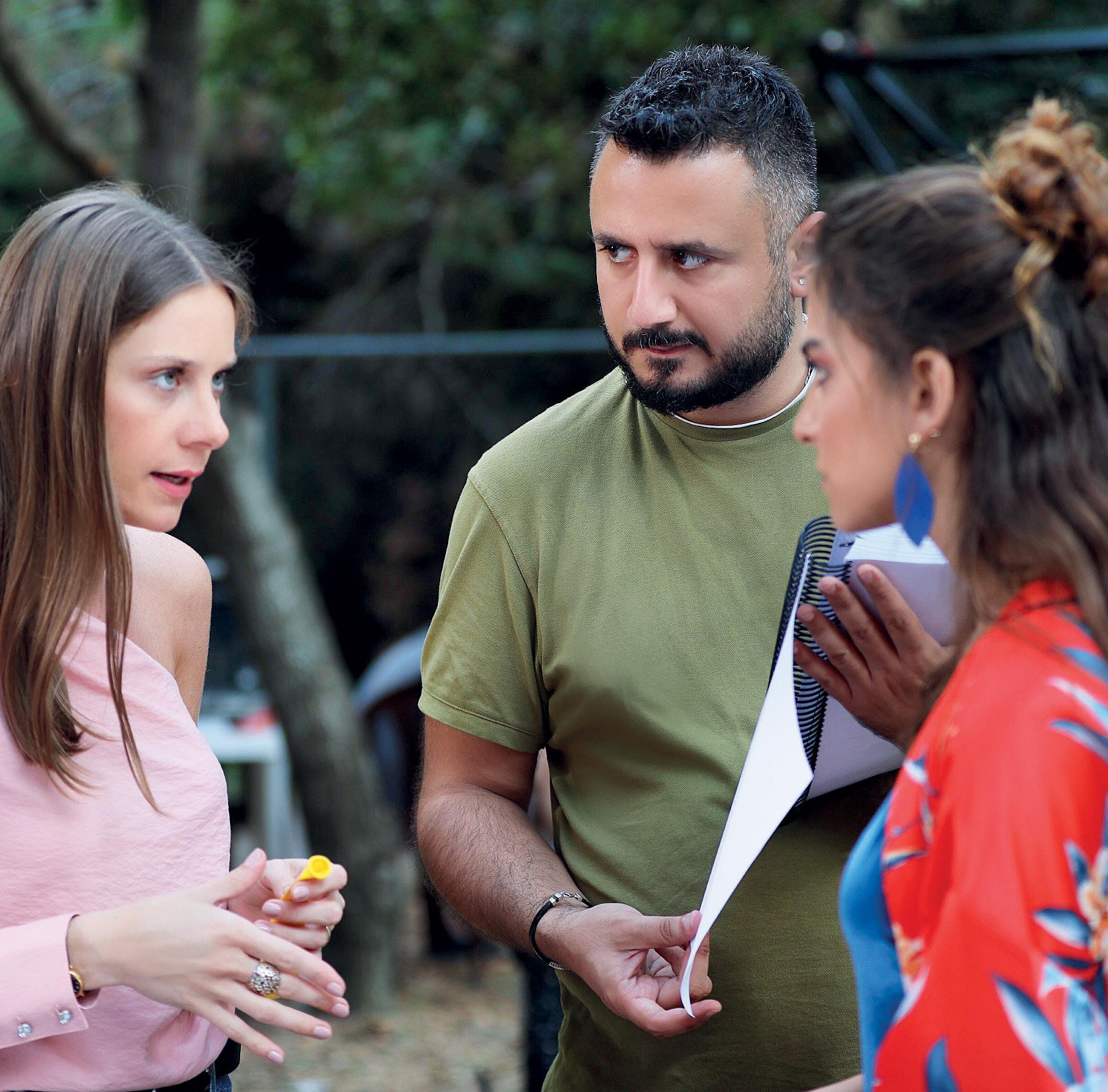
How do you approach the psychology of film themes in the Arab region compared to Western cinema?
It is key to know your audience. Who are you targeting? I reject scripts which I cannot believe – by believe, I mean those that don’t resonate with the target audience! Because it simply will not work!
Are there cultural nuances that you find particularly significant in shaping the storytelling process?
For our Arab society, emotion is key! Not necessarily sad emotions, but any emotion, be it laughter, romance, revenge, fear, sadness … we are an emotional people and we like to see this on screen!
What inspired the decision to build an actual plane for Beirut 303, and what challenges did this present during production?
I wanted it to look real. I didn’t want to take the risk of graphics looking fake. I wanted it to be a real experience, and so having the plane in the water broken in two parts even helped the actors feel the scene. The challenges were many, needless to say – we built a real-life-size plane!
What considerations and challenges did you face while bringing together multiple prominent Arab names for Beirut 303? It was a surprise for many in the industry and even for the audience, how we were able to get so many prominent Arab names into one project! But they were all great to work with and added value to the project! I think when you have a strong and successful production house backing you up, when you build a credible name for yourself and when your team is a great team, the actors feel safe and join you!

34 PRO | Q&A MARCH 2024

How has pan-Arab drama evolved, and what impact has it had on regional audiences?
It has raised the production value and exposure. It has brought cultures together. I think we are the only region which still finds this as something to question. In Hollywood, people of different cultures join together in series and films while people disregard their nationality and just focus on the art!
How do you address any controversies stirred up by panArab drama, and how do you navigate such reactions?
I think any controversy stirred up only comes from people who are racist and ethnocentric. I ignore such comments! What could be negative about us all uniting to make better drama? Why do we have to always argue about this? Let’s just enjoy the art.
How do you see Khaleeji drama shaping the broader
landscape of Arab television?
For me, watching any film or series is an experience. When I watch, I get to see and experience cultures, countries and societies I am not in direct contact with! Khaleeji drama helps us experience how Khaleeji families live, what struggles they face, what things are of value to them and how they may behave in their struggle. We are opening up to other cultures – through drama, we can break all man-made borders and let people in. This can break all preconceptions people have about the Gulf as well as the Middle East!
How do you foresee the future of filmmaking in relation to AI?
AI can be a tool to achieve even bigger things and create what we could have only dreamed of, but AI cannot feel and cannot evoke feelings! Art is based on human experience and emotions. AI is a beautiful tool made for us to make better projects, but can never replace us.
How does your approach differ when directing drama, compared to music videos?
Music videos are about portraying the best image of the singer and adding a new layer to the song. I as a director need to add value to the artist and the track and take it to the next level. In drama, it is about the story and the characters.
How has the industry evolved, and what opportunities or challenges does this present for directors?
We are all so exposed to projects from all around the world now because of digital platforms. This has raised the bar in terms of quality and story. Anything you do will now be compared to international productions, because people have access to them and can watch them.
So directors, writers, producers, etc always have to be growing, researching and developing – this is the fastest growing industry in the world.
35 PRO | Q&A
 DANIEL KAFER
DANIEL KAFER
Digital platforms transformed their narrative from simply selling media products to assisting advertisers in achieving growth and digital transformation
Digital platforms have left the door open for broadcasters
The evolving digital ecosystem offers broadcasters a chance to re-establish their prominence as the go-to partners for advertisers. This opportunity emerges as digital platforms are scaled back and operate with reduced sales teams, making it crucial for broadcasters to act with alacrity.
There have been significant shifts in the dynamics between TV stations and major digital platforms, especially since 2015. Larger broadcasters have historically enjoyed a dominant position, forming close-knit partnerships with major advertisers, collaboratively attending key events and jointly developing business cases.
However, the landscape shifted post-2015 as digital platforms like Meta and Google began to enhance their appeal. They broadened their talent pools with professionals from diverse backgrounds including consultancy, advertising and media, and introduced comprehensive training programmes covering media strategy, creative mobile optimisation and beyond.
Digital platforms transformed their narrative from simply selling media products to assisting advertisers in achieving growth and digital transformation. This approach struck a chord with advertisers, deepening the partnerships to include strategic
decisions regarding technology stacks and more. Significant budgets were diverted to digital platforms that offered advertisers comprehensive resources in media strategy, creative optimisation, measurement and digital transformation in exchange for increased spending, though with modest discounts.
In contrast, collaborations with TV stations focused on offering cost reductions for bulk advertising purchases. With several major TV stations in EMEA having sold most of their inventory, further discounts were not feasible. Shifting the narrative away from pricing has always been challenging for TV stations, particularly when media agencies often push for lower TV ad prices during media pitches.
Despite these challenges, the recent shifts by digital platforms have inadvertently opened a doorway for TV stations to reassert themselves as preferred advertising partners. These platforms have traditionally prioritised advertisers capable of significant spending growth, inherently limiting their focus to a select group. This strategy left a vast majority of advertisers feeling under-supported and less prioritised. With tech giants now scaling back their support teams, I anticipate a more concentrated focus on a few advertisers, leaving the
rest with less personalised, scaled support. This scenario presents TV stations with a golden opportunity to engage with this broader segment of advertisers, offering them valuable insights for improved marketing ROI.
The conversation around optimising video advertising for business results or measuring advertising outcomes shouldn’t be monopolised by digital platforms. Shifts in consumer viewing habits, underscored by eye-tracking studies, provide TV stations with an opportunity to lead in creating ads that align with these new patterns.
Moreover, the integration of TV and digital media in campaign planning is increasingly relevant, as many broadcasters now offer digital services. However, measurement challenges persist, especially with digital platforms operating as closed ecosystems, complicating the assessment of campaign outcomes for advertisers.
In conclusion, broadcasters are in a unique position to forge closer ties with advertisers, potentially securing a larger share of budgets at higher prices. Now is the time for broadcasters to come up with new types of partnerships that create real value.
DANIEL KAFER IS CEO OF CONSULT~XAI.COM

PRO | GUEST 36 MARCH 2024








 VIJAYA CHERIAN, EDITORIAL DIRECTOR
VIJAYA CHERIAN, EDITORIAL DIRECTOR







































































 DANIEL KAFER
DANIEL KAFER

